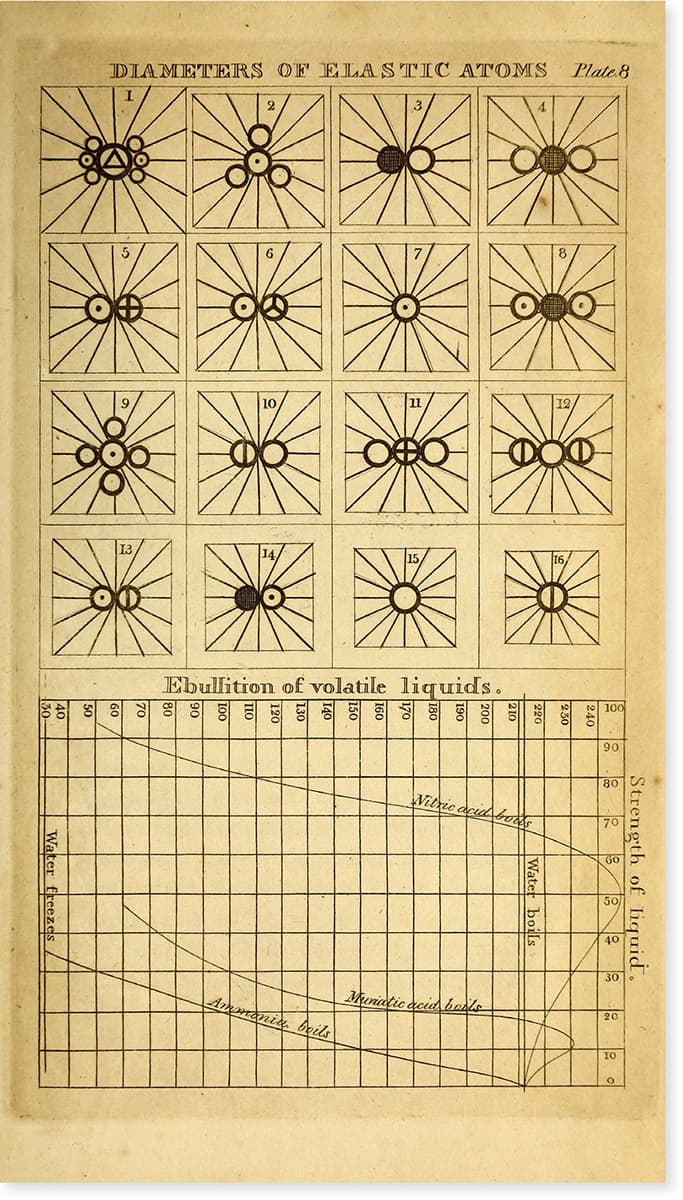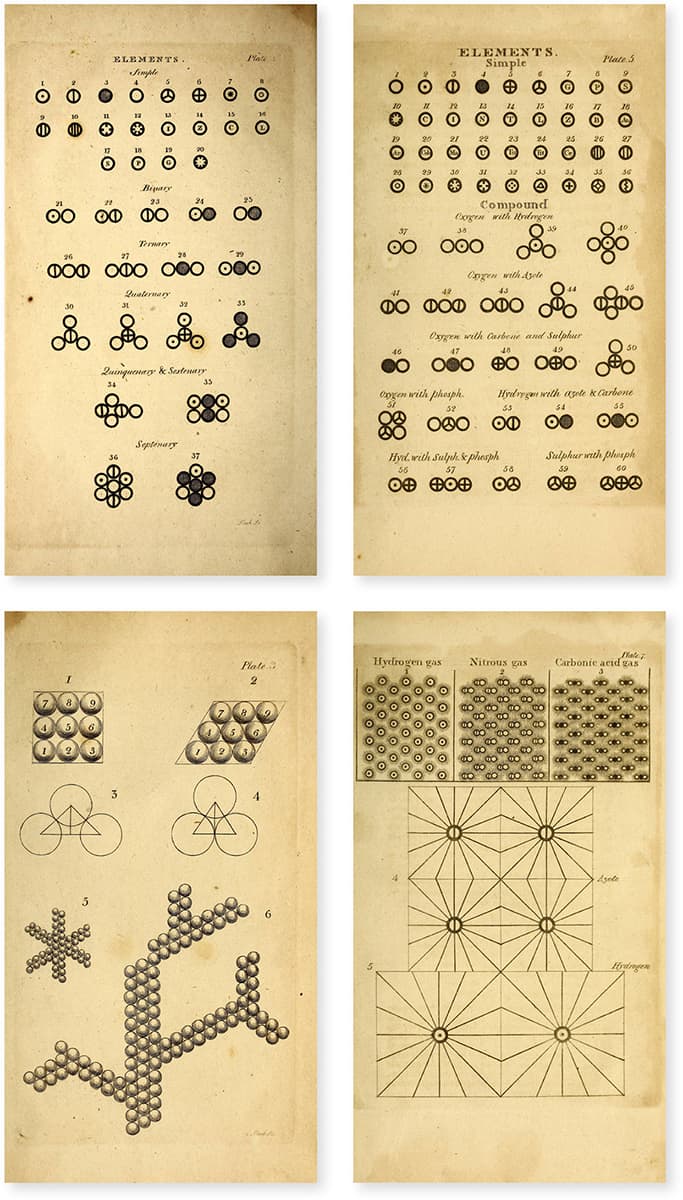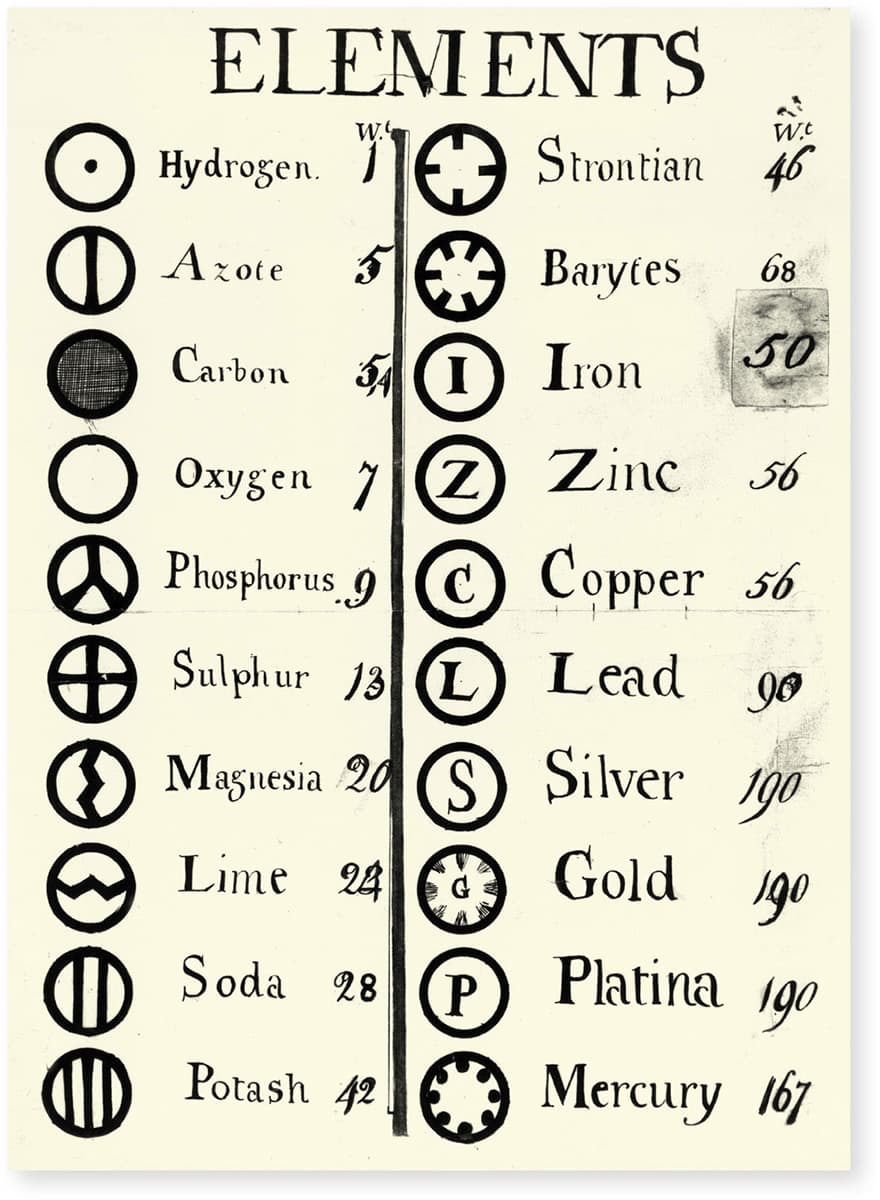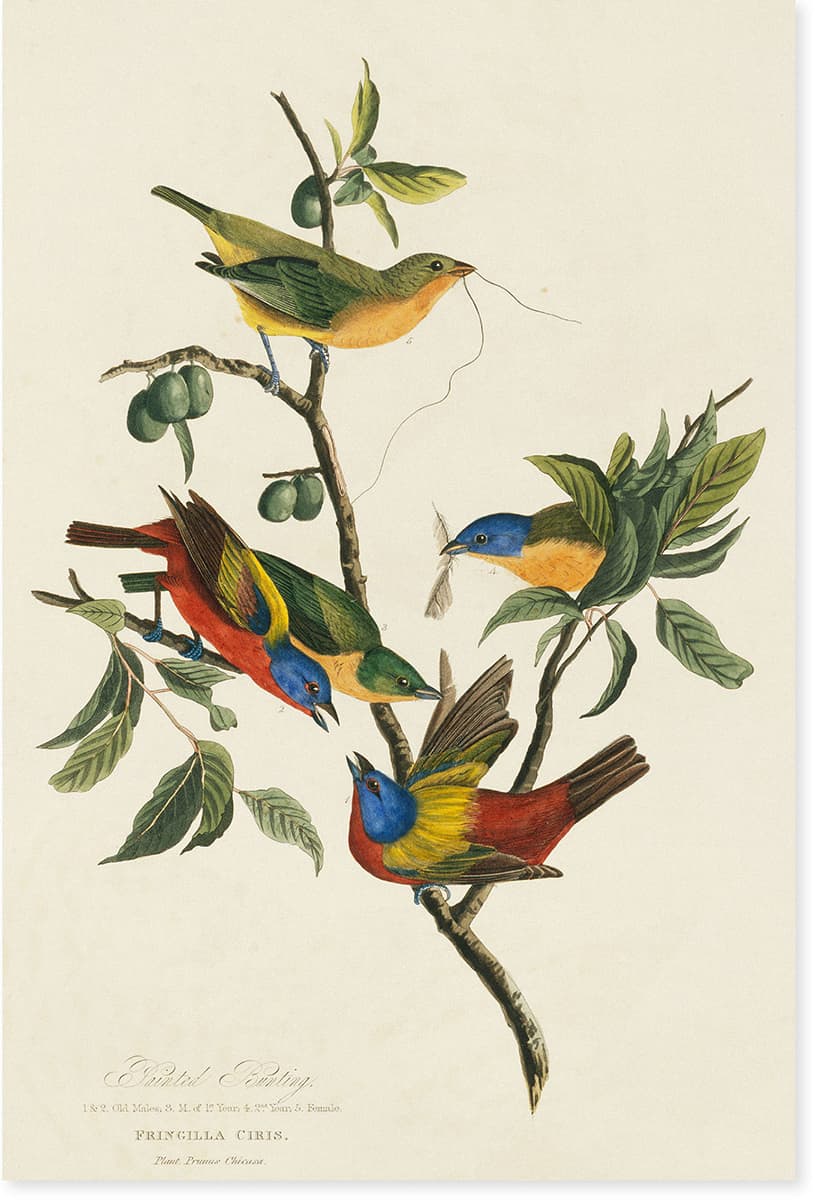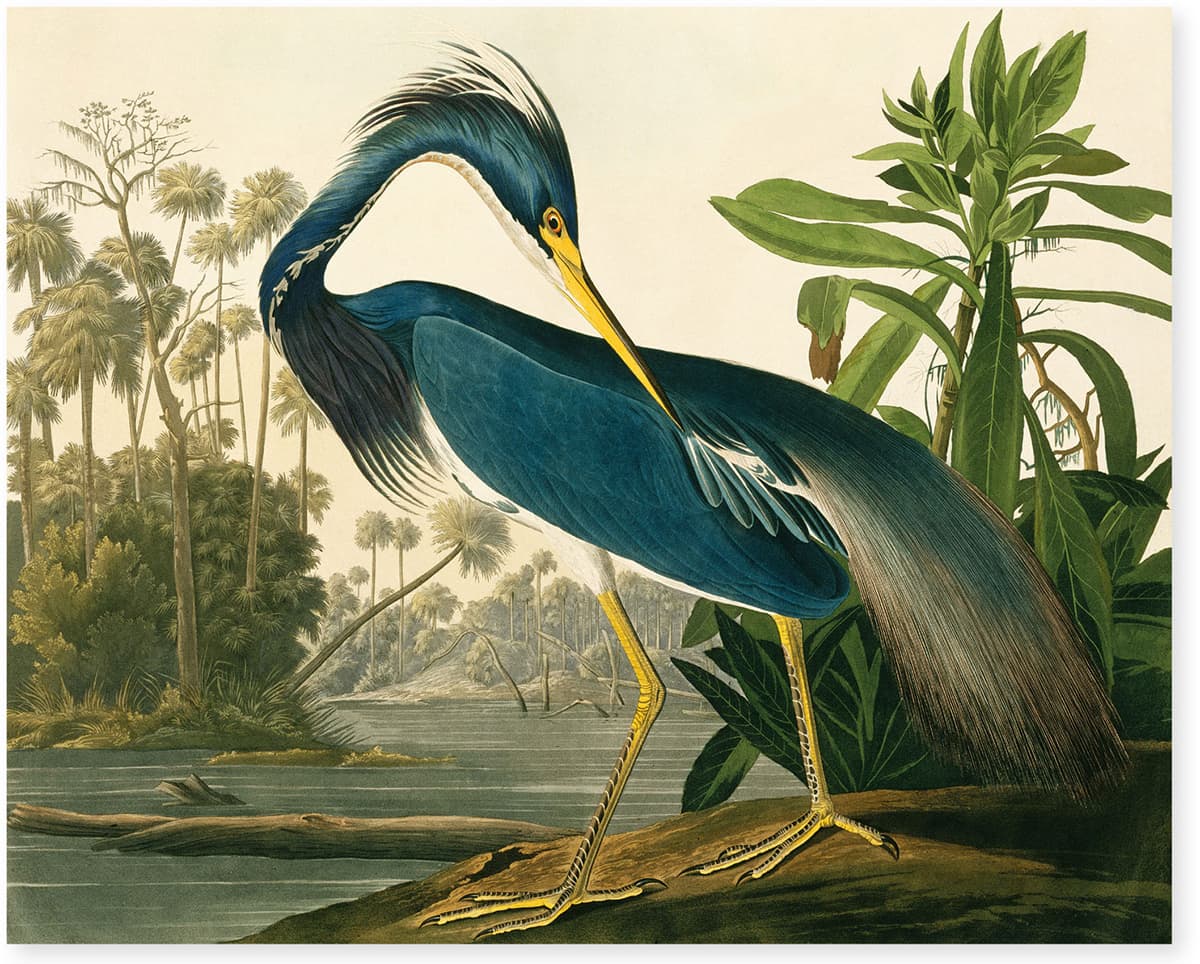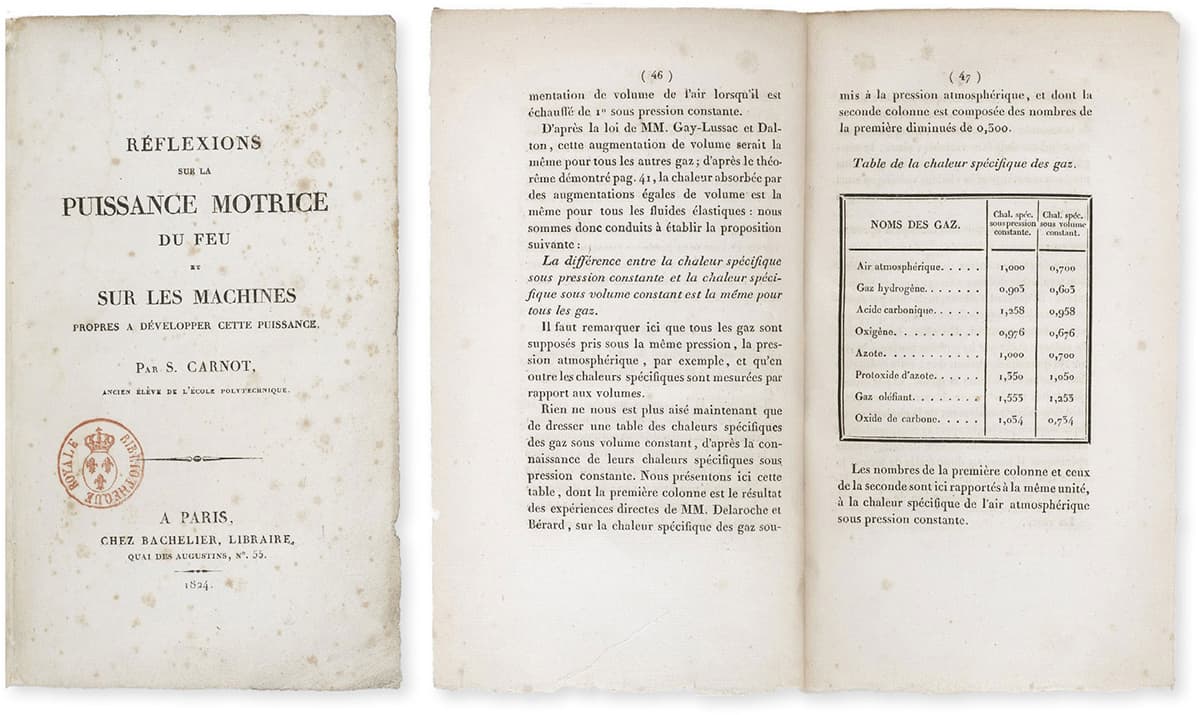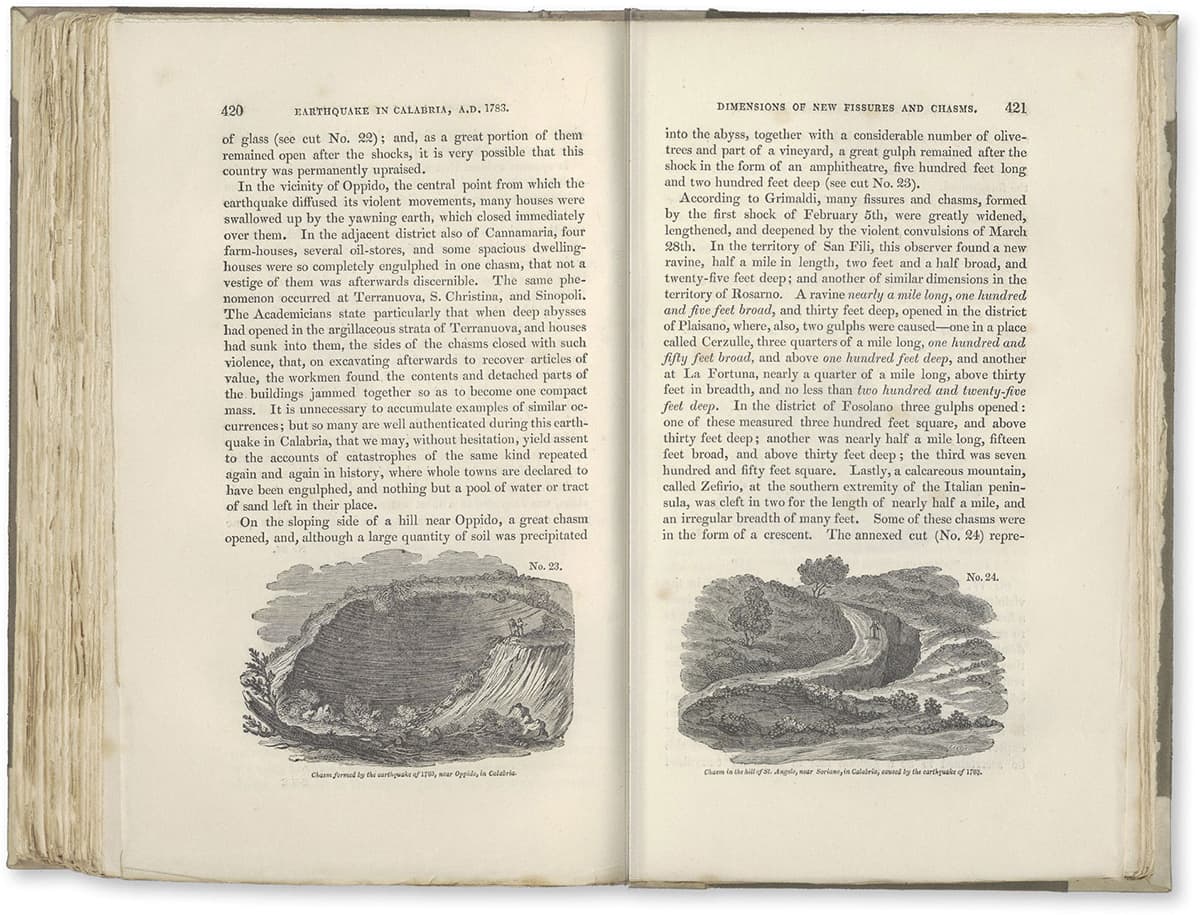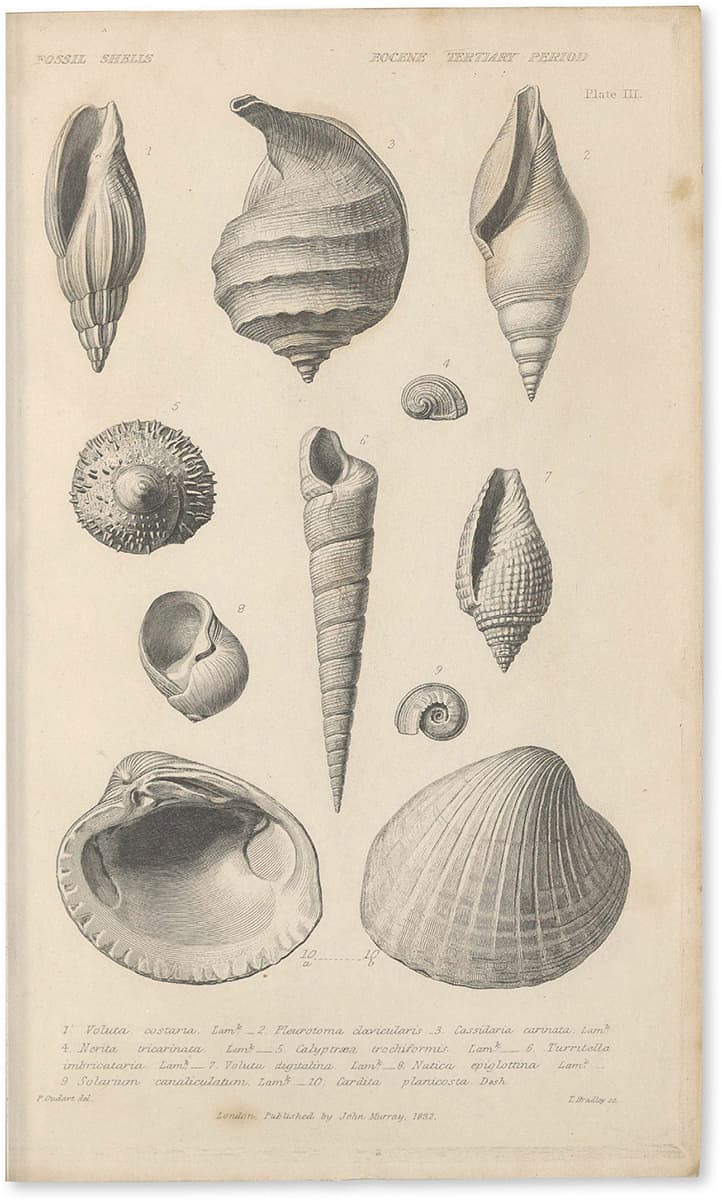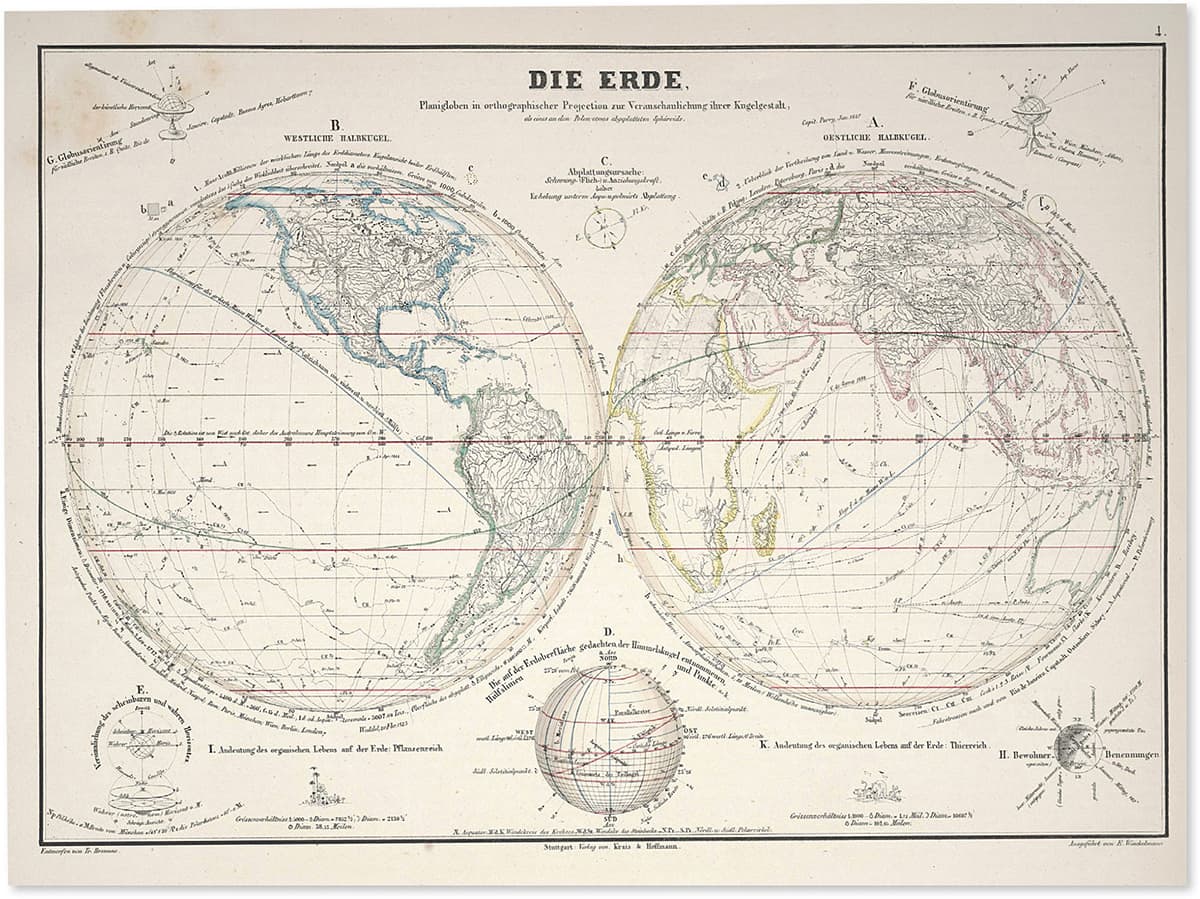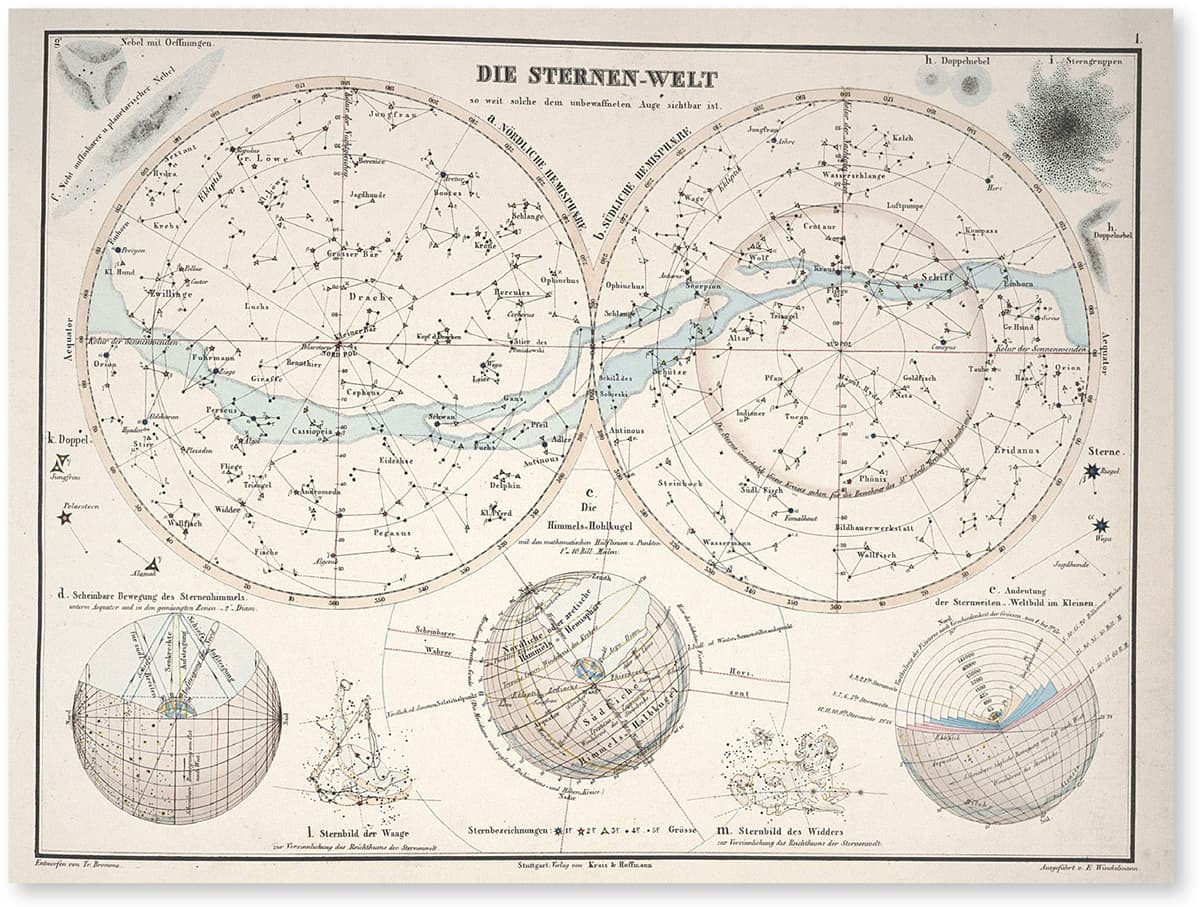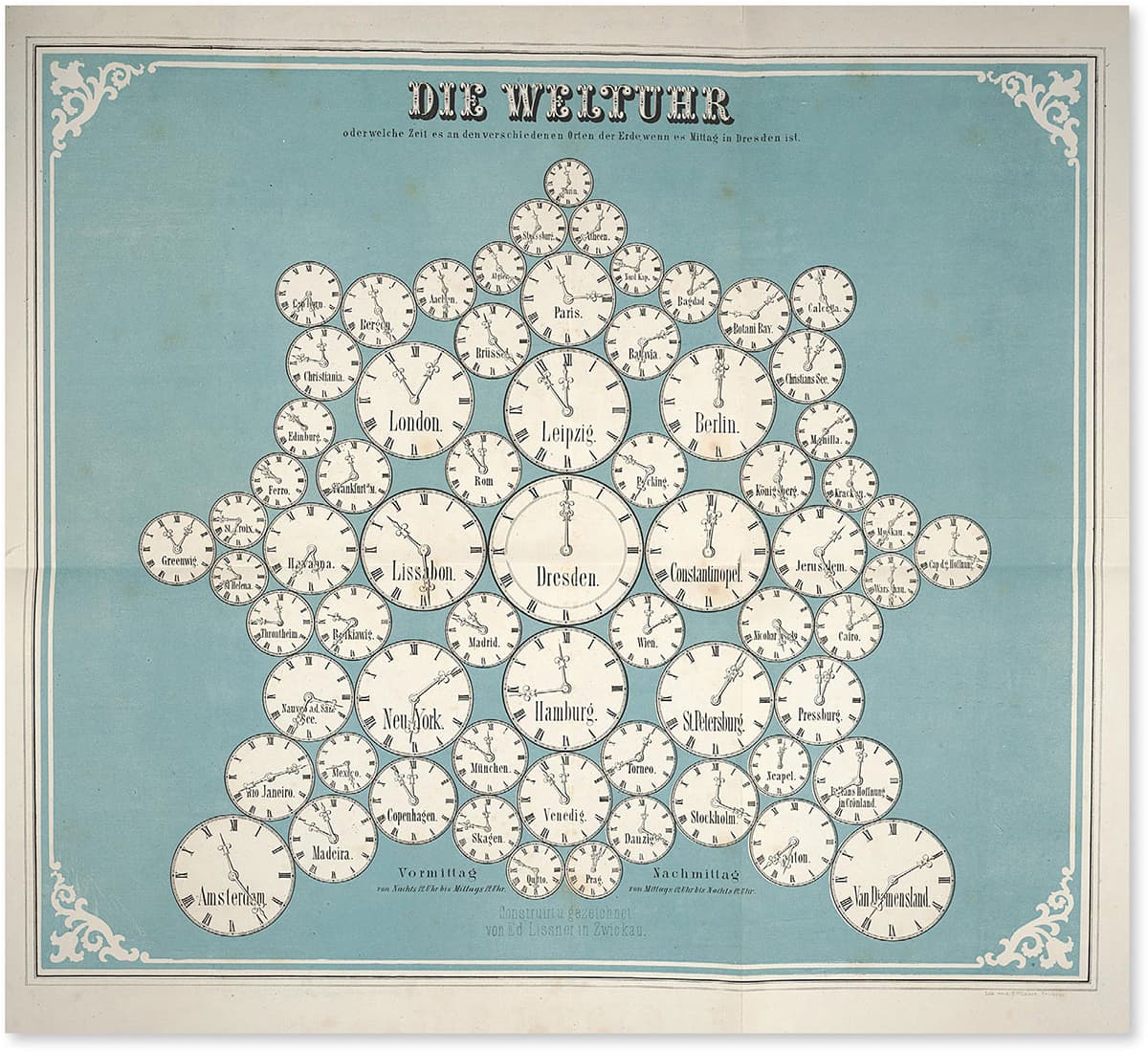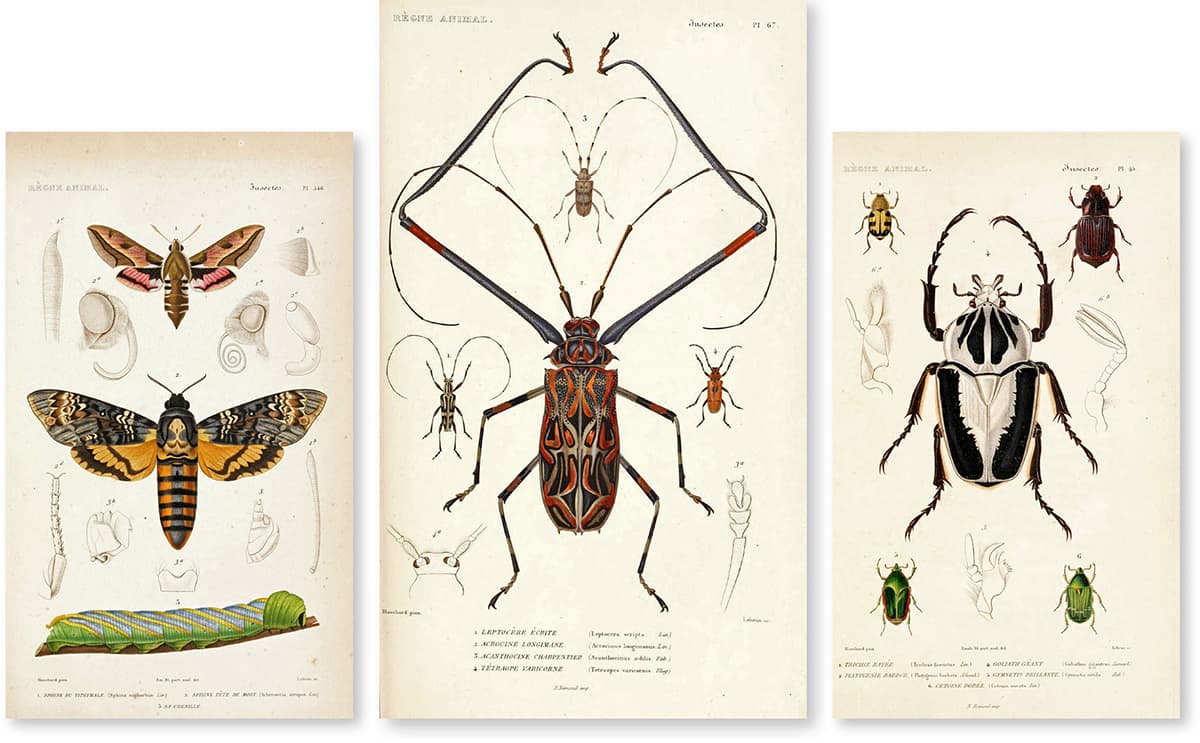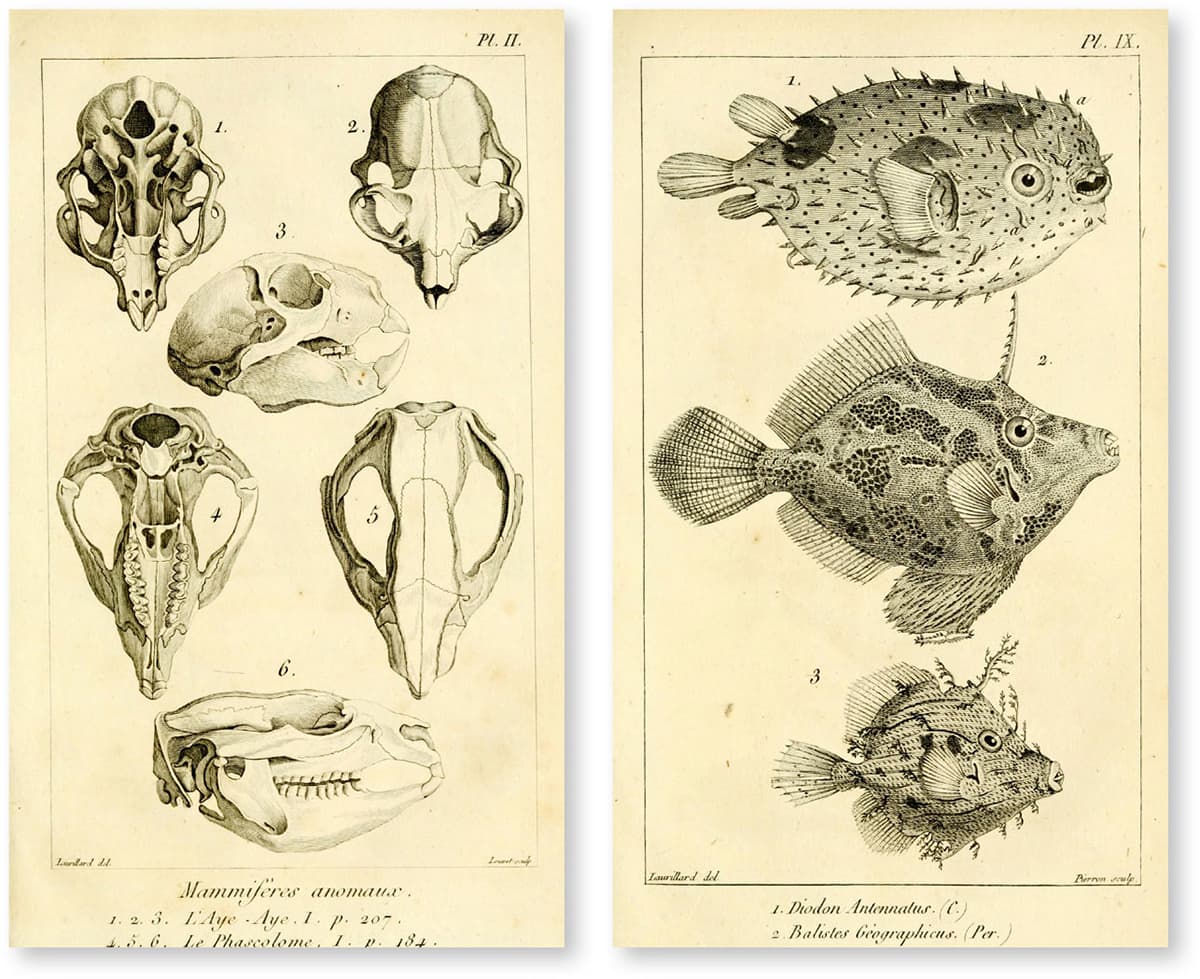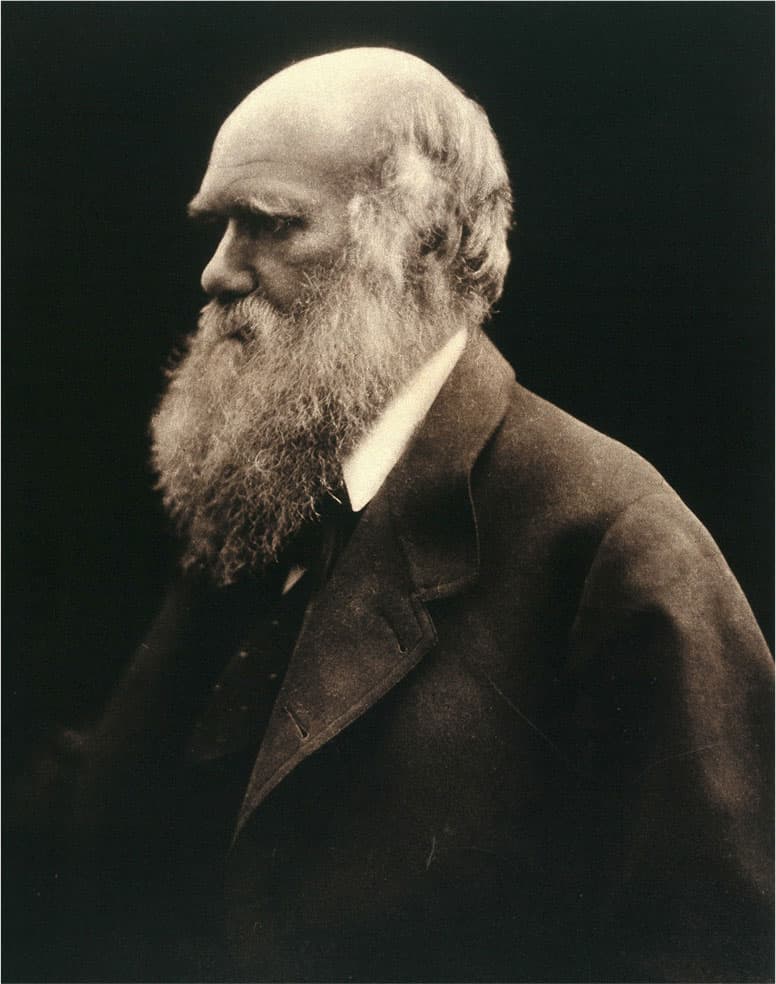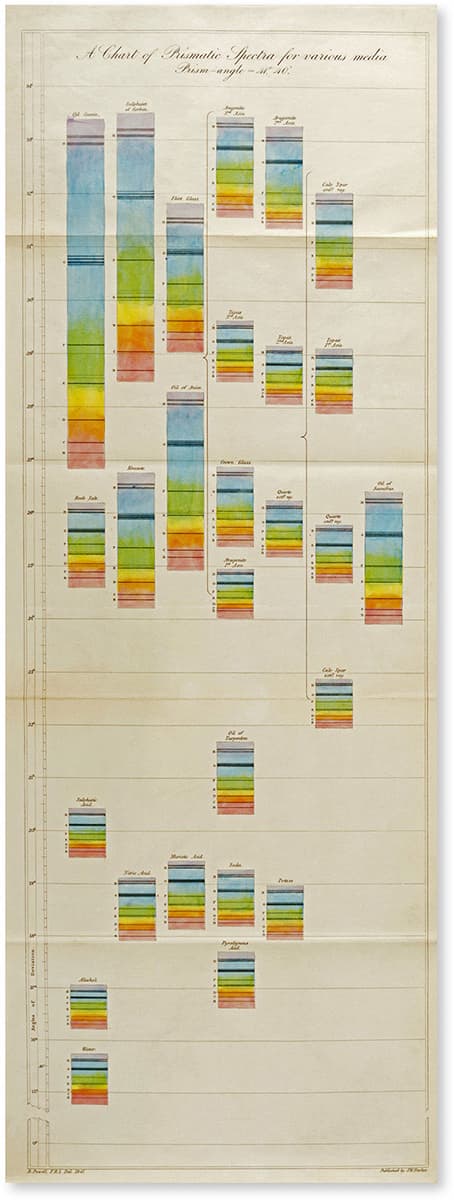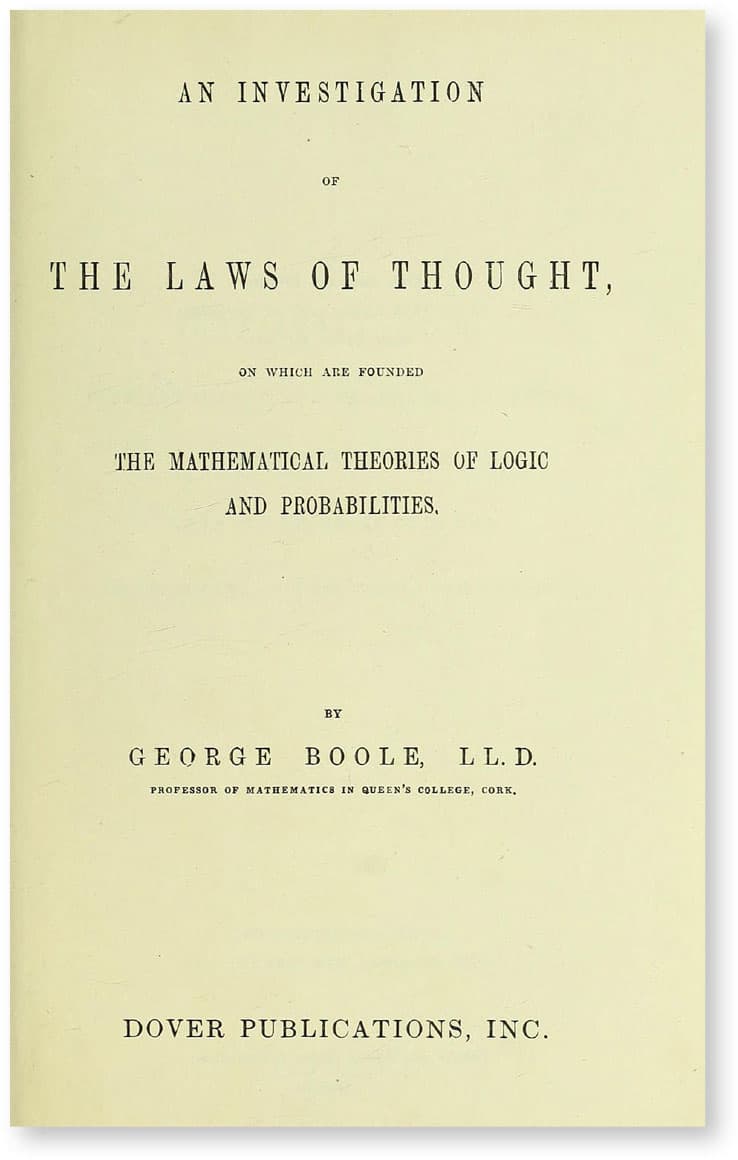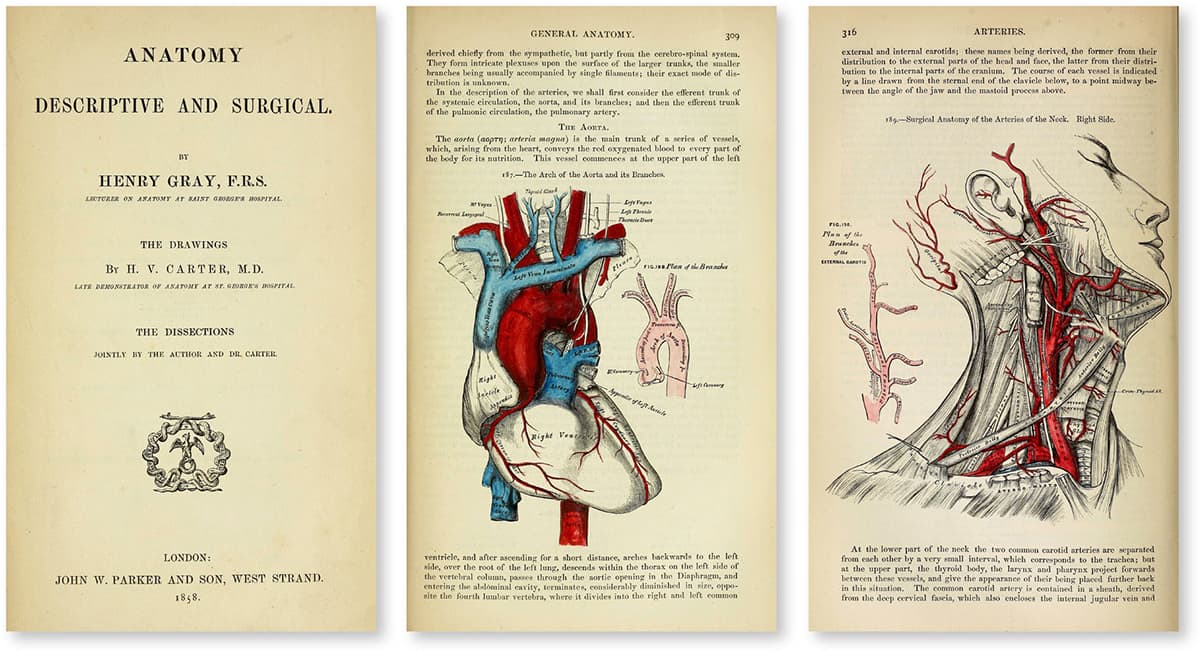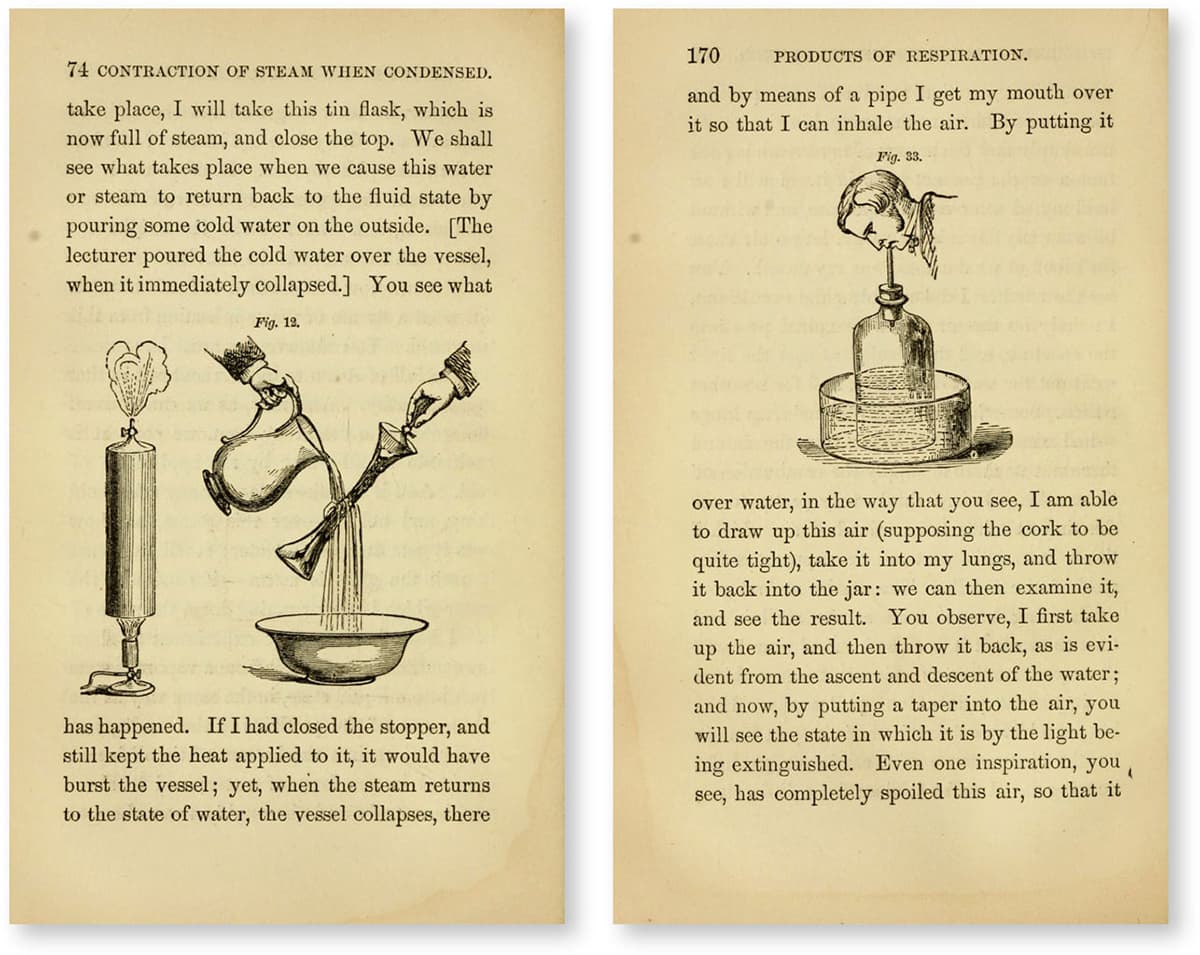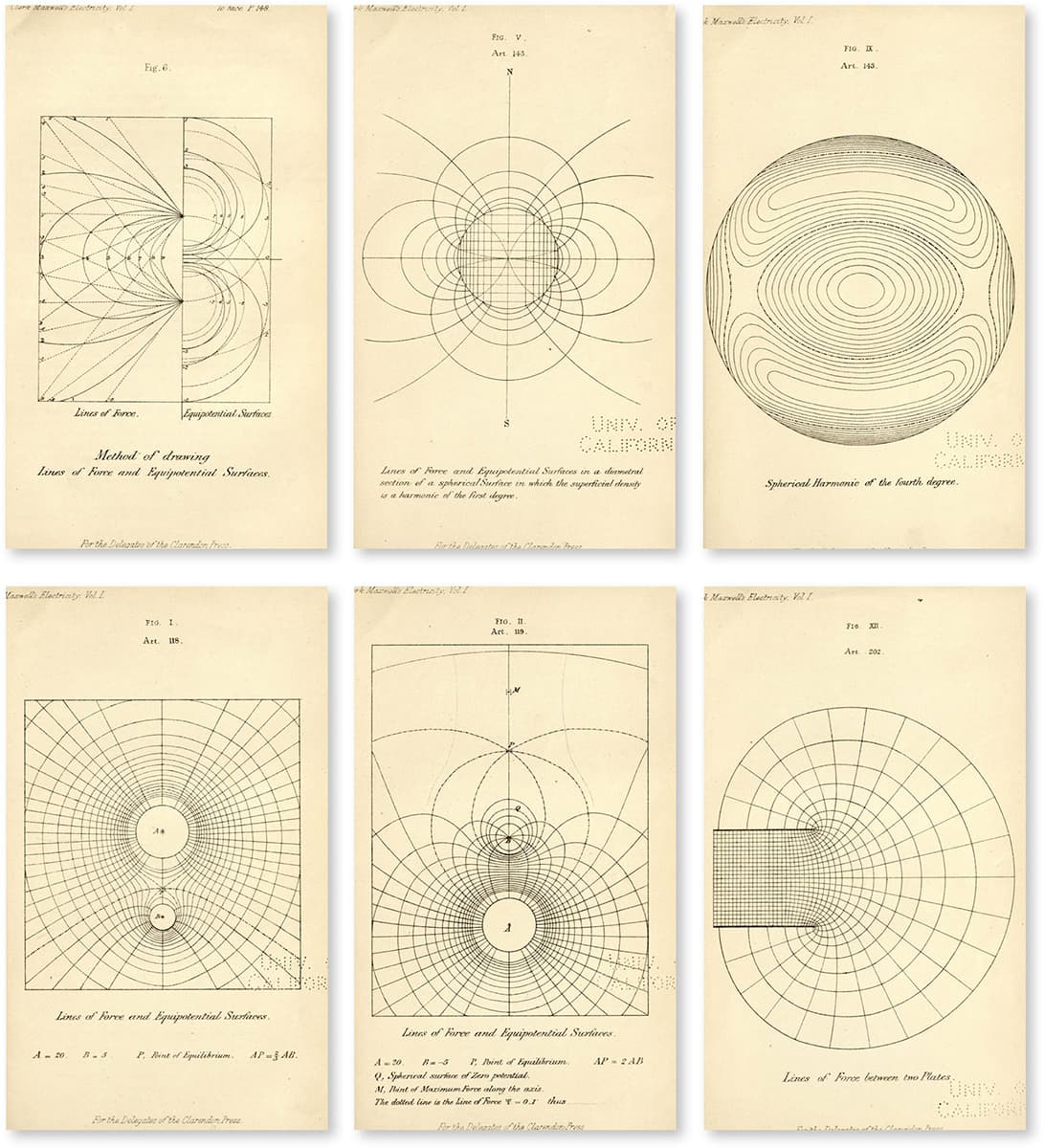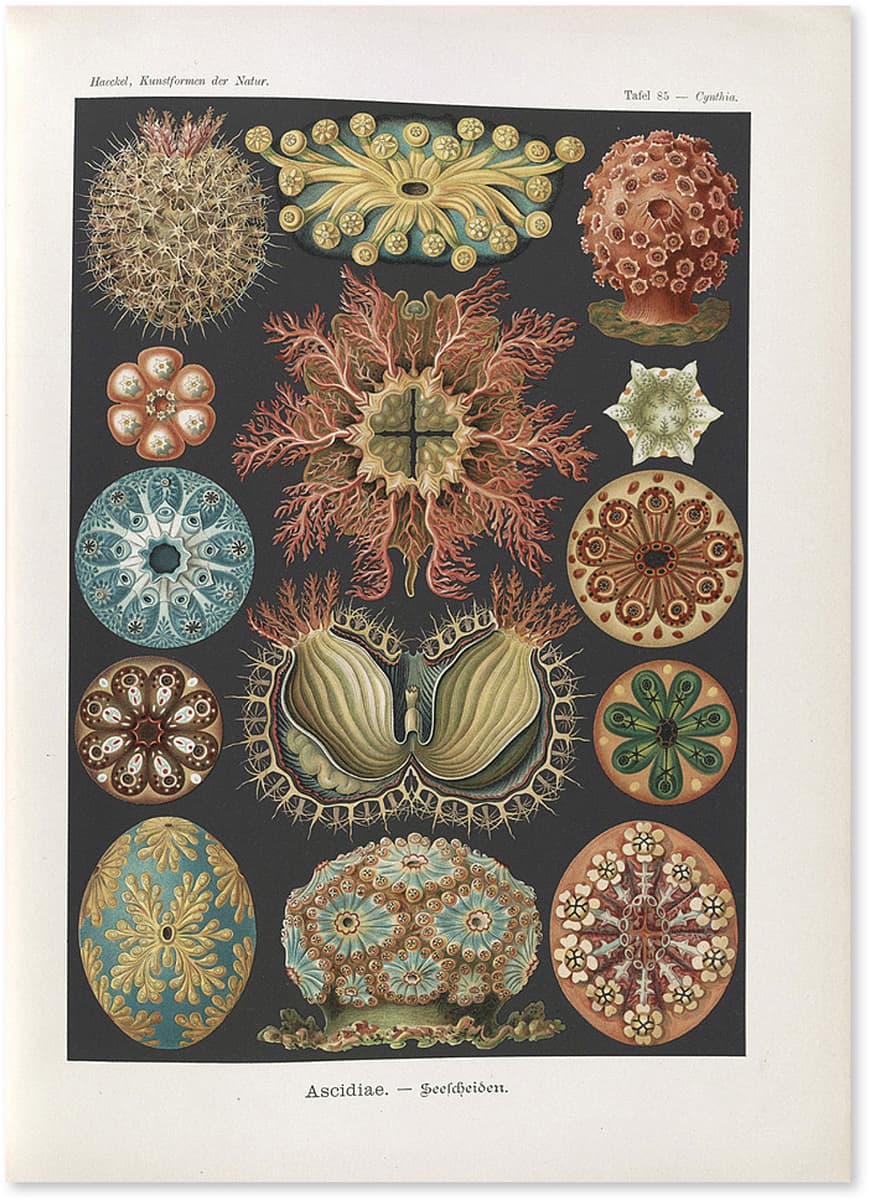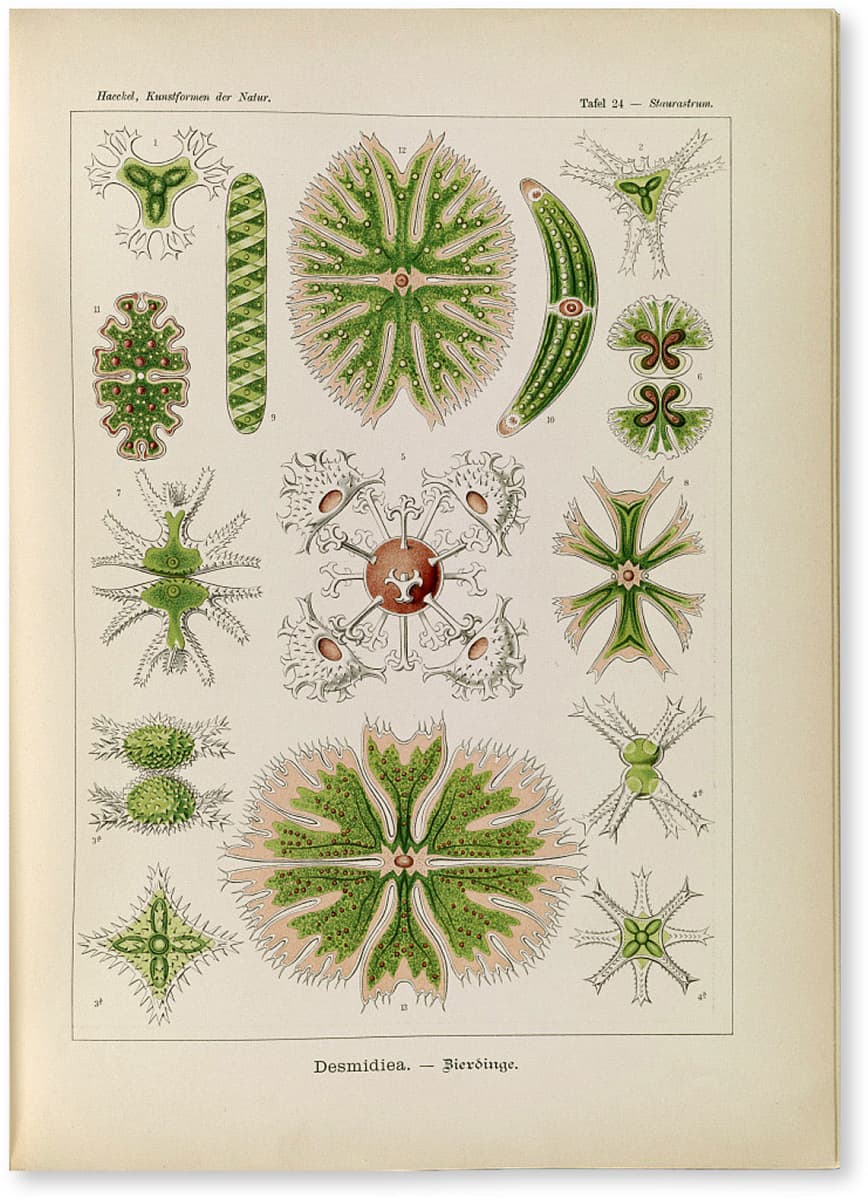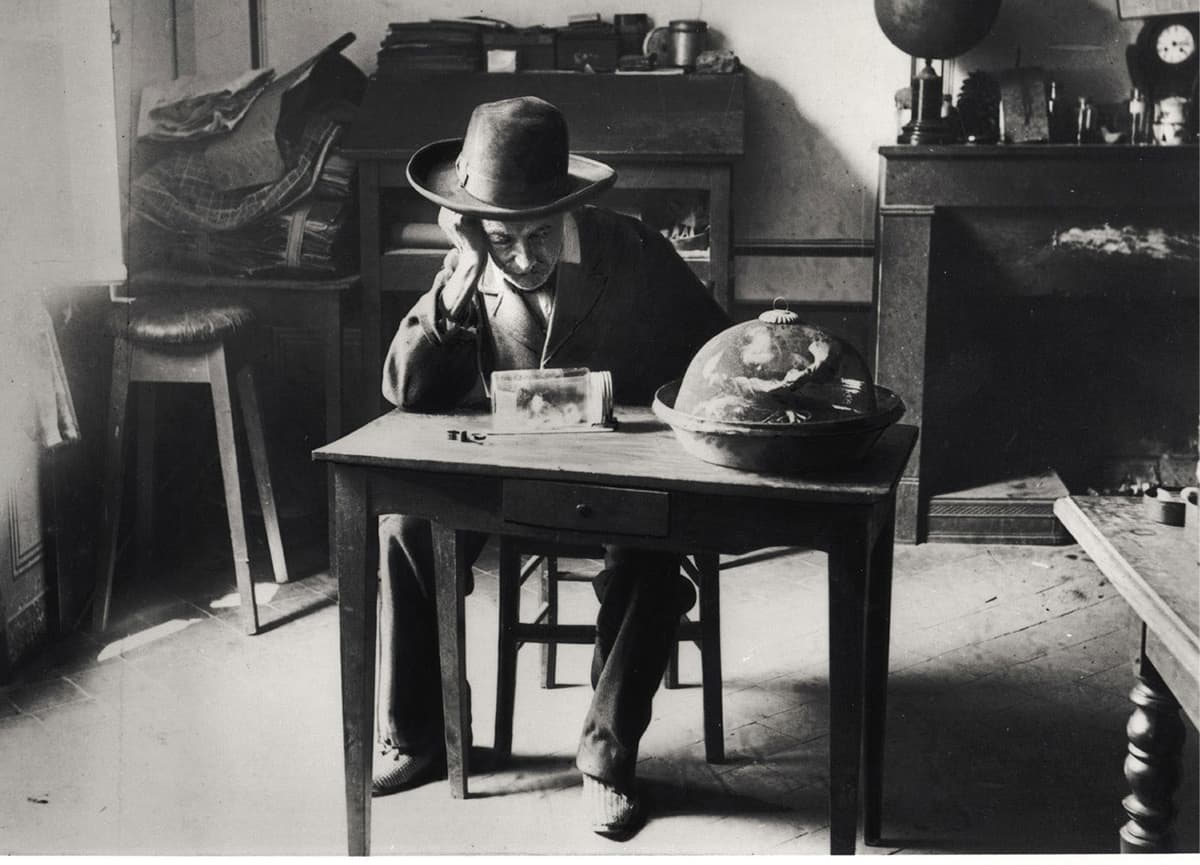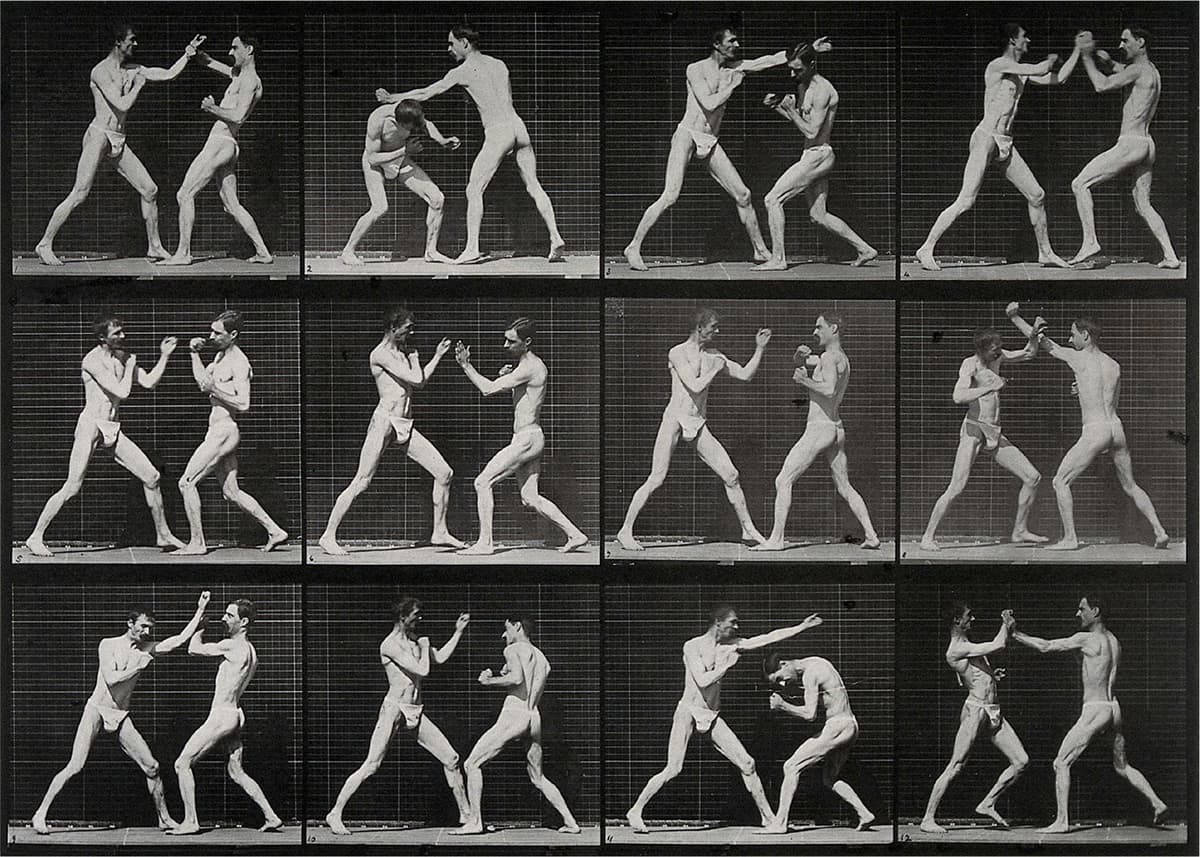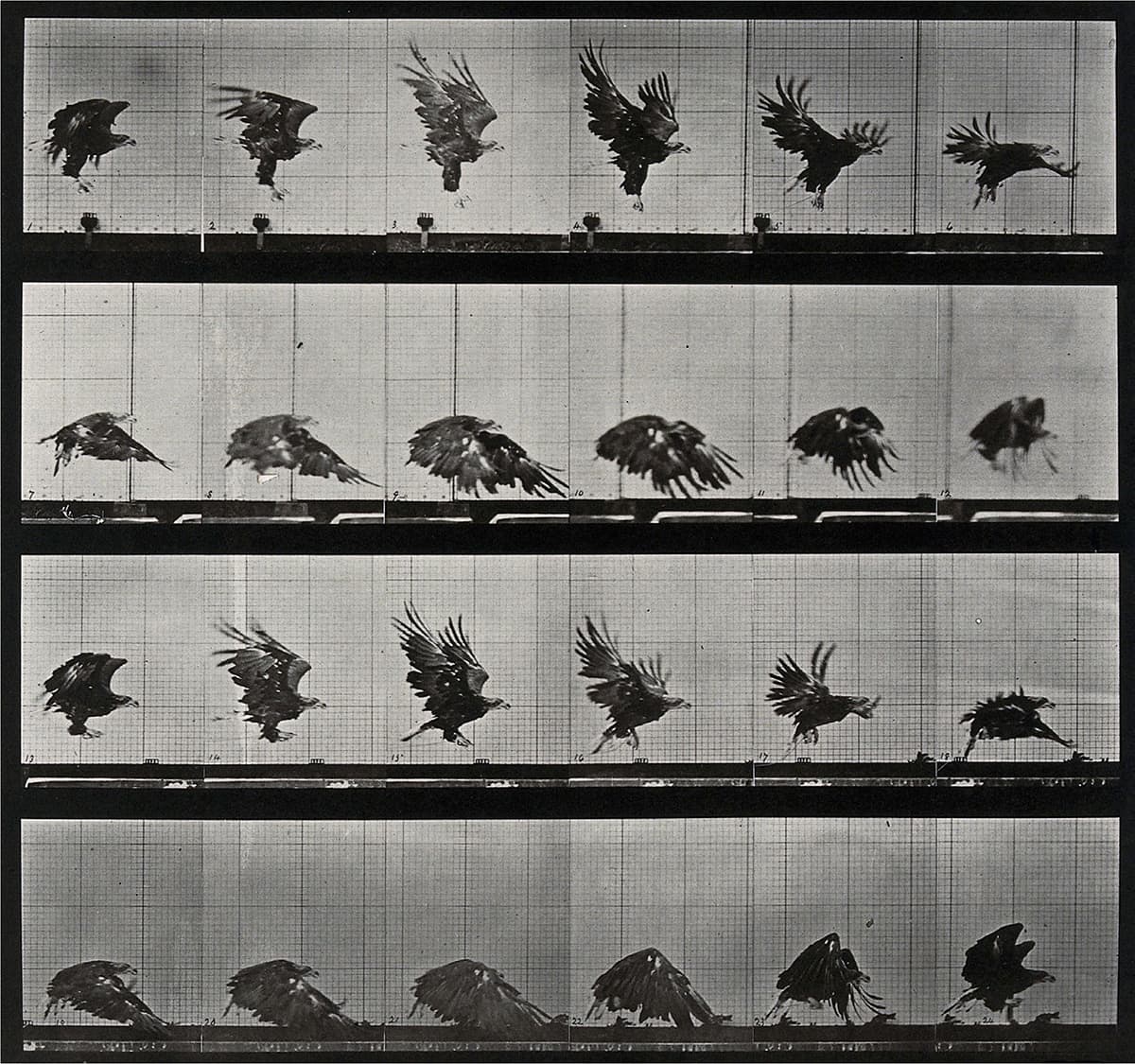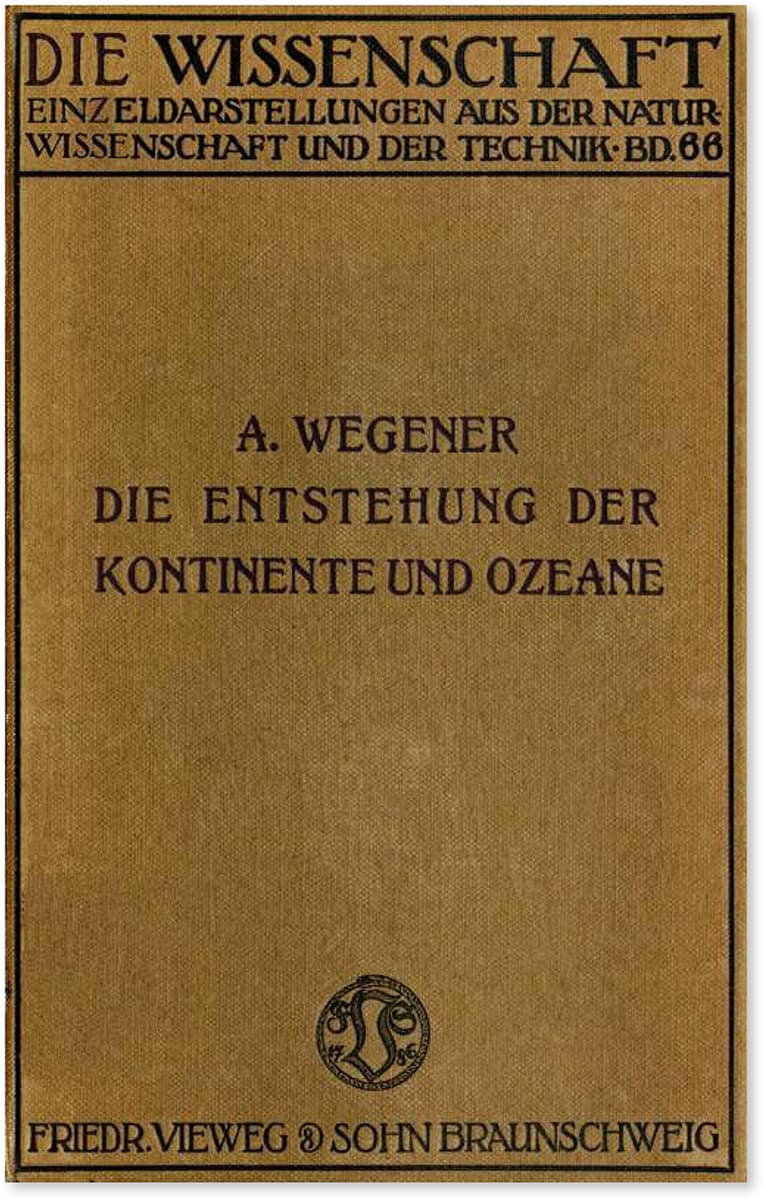3
MODERN CLASSICAL
VICTORIAN STABILITY
BY THE NINETEENTH CENTURY, science was becoming a more professional business, and science books were an expected and established part of the academic sphere. It was in 1834 that the word ‘scientist’ was coined (preferred, thankfully, over suggestions of sciencer, scientician and scientman), drawing a parallel with the likes of artist, economist and atheist. Until this period ‘natural philosophers’ were often wealthy amateurs or more general philosophers, engaging in science as a part-time indulgence.
The development of scientist as a profession was, however, a gradual process. When Michael Faraday joined the Royal Institution in London – an organisation he would eventually head up – in 1813, becoming an assistant to leading light Humphry Davy, his position was more that of a servant than an equal. (In fact, when Faraday accompanied Davy on a European tour, Davy expected him to act as a part-time valet.)
Initially, professional scientists formed a second tier alongside the amateur natural philosophers. Their relationship was not dissimilar to the cricket teams of the nineteenth and early twentieth centuries: largely amateur but including a (working-class) professional to improve their game. More of the most important books we will encounter during this period were written by amateurs than by professionals.
Mr Atom
Despite the prevalence of amateurs, one of the first important science books in the nineteenth century was written by one of the new professional class. John Dalton (like Faraday) had no university education, but became a working scientist through personal drive. Dalton was born in Eaglesfield in the northern English county of Cumberland in 1766. Dalton, also like Faraday, came from a poor family, but even had he been wealthy, he would have been unable to attend university in England as places were still restricted to members of the Church of England, and Dalton was a Quaker.
Dalton was paid to teach, not to undertake research, but to all intents and purposes his scientific work was his main job, with the teaching merely a means to make ends meet. Like most of the scientists of the period, Dalton had wide-ranging interests, from the behaviour of gasses, via meteorology, to the causes of colour-blindness (Dalton was himself colour-blind, and for a while the condition would be known as Daltonism). However, there is no doubt that Dalton’s scientific claim to fame was his work on atomic theory, first published in a series of essays in 1802.
At the time, atoms were still a subject of debate. In fact, they would not be fully accepted until the twentieth century, when a paper by Einstein gave very strong evidence for their existence. Some scientists accepted that atoms were real; others – probably the majority – felt that they were a useful accounting technique but didn’t represent real entities, while a few still felt that atoms were philosophically objectionable. Dalton was strongly in the realist camp and put forward a model of the nature of matter using what was largely Lavoisier’s chemistry (see here), based on the existence of atoms and of compounds formed by combining them.
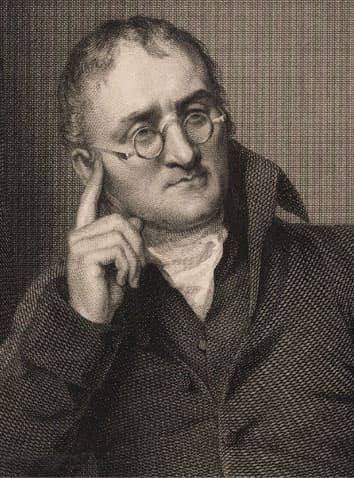
William Henry Worthington
JOHN DALTON OF MANCHESTER, ENGRAVING, CA. 1823
Engraving of John Dalton after an oil painting by Joseph Allen.
Augustus Pugin and Thomas Rowlandson
LIBRARY OF THE ROYAL INSTITUTION, AQUATINT, 1809
An aquatint of the library of the Royal Institution, Albermarle Street, London.
John Dalton
A NEW SYSTEM OF CHEMICAL PHILOSOPHY, PART II OF II, ROBERT BICKERSTAFF, 1810
A plate from part II of Dalton’s book showing some of his proposed molecular structures and the boiling points of differing concentrations of compounds.
John Dalton
A NEW SYSTEM OF CHEMICAL PHILOSOPHY, PART II OF II, ROBERT BICKERSTAFF, 1810
Plates from part II of Dalton’s book showing his symbols for elements, some suggested molecular structures and his ideas on crystalline solids.
John Dalton
TABLE OF ELEMENTS, 1808
A diagram created to accompany Dalton’s lectures on atoms and atomic weights showing the relative weights he ascribed to the atoms and his icons for the elements.
Often a new way of looking at what is already known can give insights. Dalton’s breakthrough inspiration was that each atom of an element had a distinct mass. He made the mass of hydrogen (the lightest element) 1 and assigned to the others multiples of this, for example, azote (nitrogen) was 5, oxygen 7 and phosphorus 9. These relative masses were (somewhat confusingly) referred to as atomic weights, the term that is still most commonly used. When two elements reacted to form a compound, the result was that their atoms combined to form molecules with the combined atomic weight of the two. In a flurry of papers from 1802 to the publication of his book A New System of Chemical Philosophy in 1808, Dalton circulated and expanded on his theory, providing elegant tables of the elements, each of which he identified with a unique symbol.
Dalton’s work had its limitations. It was based on his own experiments, which used poor-quality instruments, even by the standards of the day. As a result, his atomic weights were often incorrect. Furthermore, from his original theory that all atoms had a mass that was a multiple of the mass of hydrogen, he never made the much greater leap to the idea that all atoms were made up of multiples of hydrogen-like components (as is the case). This was probably because Dalton always referred to the ratios of atomic weights as, say, ‘nearly 7:1’ – he didn’t think these ratios were exact, and because he was sure that atoms were spheres of different sizes, his mental model of them did not fit well with the idea that all atoms were constructed from hydrogen-like building blocks.
Like Lavoisier, Dalton failed to spot that some compounds – lime, for example – weren’t elements, and he also miscalculated the number of atoms in molecules, usually assuming there was one atom of each element: he thought that water was HO, for example, rather than the now familiar H2O, and he missed that oxygen came as a two-atom molecule. Dalton also refused to accept the simpler text-based symbols we use today, which were introduced by the Swedish chemist Jöns Jacob Berzelius, and already in use before Berzelius’s most significant book, his 1808 Läroboken i Kemien (Chemistry Textbook). Instead, Dalton insisted on using his own pretty looking, but hard to remember, icons for each element.
Despite these flaws, we have to remember that Dalton was a pioneer in his field – and so not likely to get everything right – and was working without the support of a university or the high-quality instruments a rich amateur scientist of the period could have obtained. He was also working at a time when some of the elements, such as oxygen and nitrogen, were still relatively newly discovered. His book brought to the world of chemistry a new rigour and method.
The ultimate birdwatcher
Books like Dalton’s were still primarily aimed at other natural philosophers, but the nineteenth century also saw the gradual appearance of books that would not only appeal to scientists, or even those with an interest in science, but to a wider audience. A prime example of this is Audubon’s Birds of America, which at the time was seen much as we might today consider a coffee-table book of images from the Hubble Space Telescope. Although the book’s original images were made for a scientific purpose, their primary appeal to the wider public was in their visual beauty – there probably had not been an equivalent book since Hooke’s Micrographia.
With a remarkable mixed heritage, Birds of America was written by a Haiti-born Frenchman who had American citizenship (despite being an illegal immigrant), and it owed its existence to the enthusiasm of a British audience. Published in 1827, it featured 435 prints, each hand-coloured, and contained a remarkable array of birds on its huge 99 x 66-cm (39 x 26-inch) plates. Shortly after his arrival in America in 1803, John James Audubon started to take an interest in the wide range of American birds. Not only did he observe them and paint them, he learnt taxidermy and set up a natural history museum that included a wide range of American native species, both birds and other animals. Audubon’s day job was as a merchant, but his enthusiasm for natural history gradually took over more and more of his life.
Unlike many involved in science at the time, Audubon was not independently wealthy. When, for example, his latest venture of a flour mill went under in 1819, Audubon was bankrupted and sent to debtors’ prison. Even so, by 1820, he was once again on the road, painting birds, with a grand plan in place of putting together a collection of images of all the birds of North America. By the time he reached Philadelphia in 1824 he had accumulated over 300 images and hoped to make a book from them – but couldn’t find a publisher.
John James Audubon
BIRDS OF AMERICA, R. HAVELL & SON, 1827
Plate 53 from the original ‘double elephant’ folio of hand-coloured aquatints, showing painted buntings engraved by Robert Havell junior, who printed the book with his father, Robert Havell senior.
John James Audubon
BIRDS OF AMERICA, R. HAVELL & SON, 1827
Plates 217 and 386 from the original ‘double elephant’ folio of hand-coloured aquatints showing a Louisiana heron and a white heron.
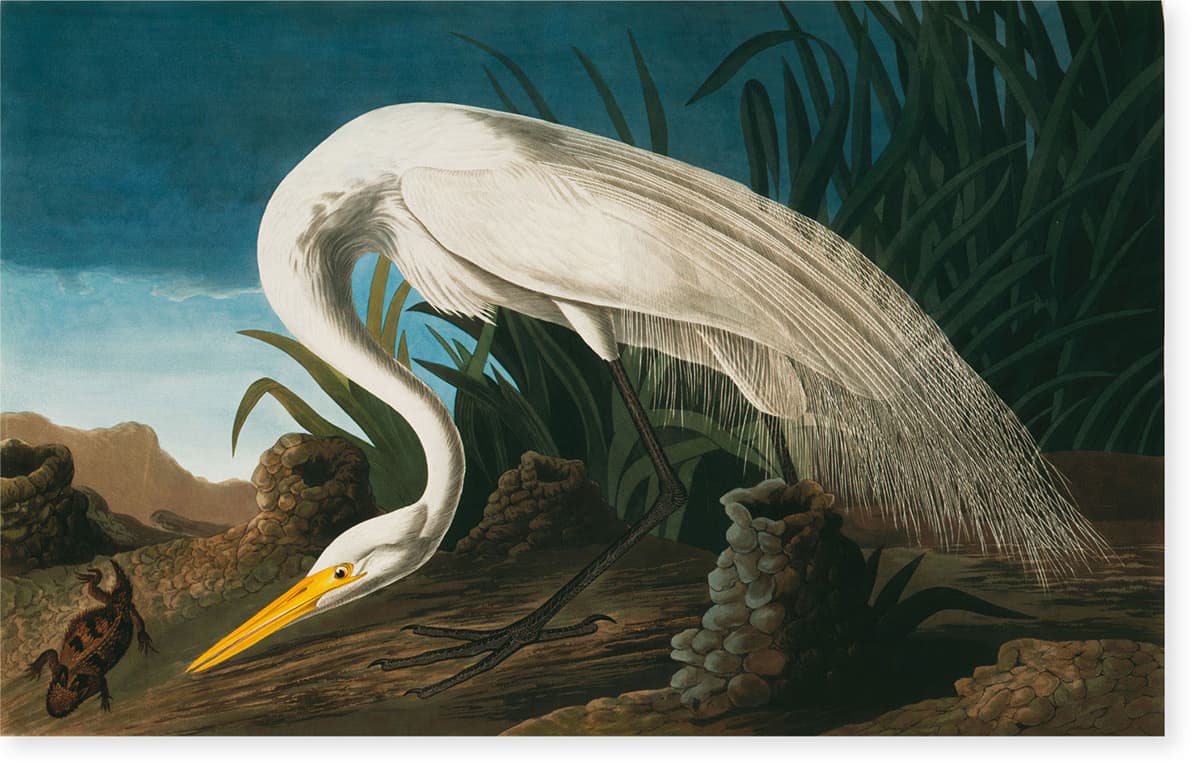
On the recommendation of a friend, Audubon travelled to England, and finally found the enthusiastic audience he required (in part inspired by his exotic, backwoodsman persona) and the funding to publish his great work. The whole book was not produced at once. Instead, subscribers would receive five prints at a time in a tin box. Like most books of the time, the single pages would then be bound by the buyers themselves, with a cover added to match their libraries. The book cost a phenomenal amount to print; even at that time, to buy a full set of all 435 prints would have cost around $1,000 – equivalent to around £20,000 or $26,000 in modern terms. A complete Birds of America sold at auction in 2010 for £6.5m ($10.3m). Only relatively few copies of the full-sized edition were produced, but a smaller 25.3 x 15.8-cm (10 x 6.25-inch) version had a far wider circulation.
Although the illustrations were issued separately, there was also a five-volume text to accompany them, written by Audubon in collaboration with the Scottish natural historian William MacGillivray. This was published independently to avoid having to provide free copies of the expensive illustrations to the British Crown Libraries, which as the UK national library receives copies of all British publications.
Scientific manufacture
In the modern sense, Birds of America did little to advance science. It was purely a matter of data capture, with no theoretical use made of that data. Yet it provided a unique view of the avian natural history of North America, and stood out for the way in which its visual splendour turned a scientifically inspired publication into an object of desire for ordinary citizens. A totally different, but highly influential book, was published just five years later. Here it was not the pictures, but the theory, that was central to its success. The author, Charles Babbage, wanted to bring science to the business of manufacturing.
We now remember Babbage, born in London in 1791, for his work on early mechanical computers. However, his computers were never completed, and he did not write an influential book on the subject. The closest we come to this was more in the form of a paper, the 1842 Sketch of the Analytical Engine invented by Charles Babbage (with additional notes by Augusta Ada, Countess of Lovelace). This was a piece written in French by the Italian general and mathematician Luigi Federico Menabrea, which was translated and doubled in length with notes by Ada King, the Countess of Lovelace, who worked with Babbage on the way his mechanical computer could be programmed.
However, Babbage did not spend all his time on calculating engines. He also considered ways to apply mathematical and organizational principles to the workplace. A much-expanded version of his approach would become a branch of applied mathematics in its own right (called operational research) in the 1940s, when it was first applied to wartime problems and later to business. Babbage made one of the first attempts to bring science to the operations of the business world.
His book, On the Economy of Machinery and Manufactures was published in 1832. In researching it, Babbage put time into observing what went on in factories and realised that skilled workers were spending a considerable amount of their time on unskilled labour. He suggested that dividing up tasks, so that the skilled workers could concentrate on their skills, would result in greater efficiency. Babbage was also one of the first to look at breaking down costs to understand the profitability of a business and to examine the benefits of profit-sharing.
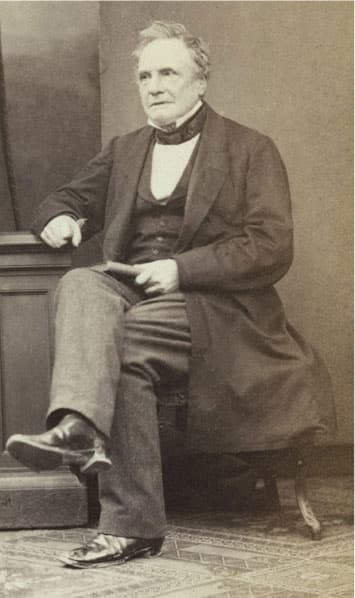
CHARLES BABBAGE, CA. 1860
A relatively elderly Babbage in an undated photograph.
Charles Babbage
DIFFERENCE ENGINE NO. 2, 1847
Technical drawing of Babbage’s Difference Engine number 2, his mechanical calculator, which was partly constructed but abandoned as he went on to design his more advanced Analytical Engine.
The dramatic changes in industry of the time were taking place in large part as a result of the introduction of the steam engine. But, initially, the science behind this transformative technology was sketchy at best. The book that would change that was written by a young French engineer, who would sadly be dead of cholera by the age of 36. This was Nicolas Léonard Sadi Carnot, born in Paris in 1796. Carnot effectively began the branch of physics later known as thermodynamics with his 1824 book Réflexions sur la Puissance Motrice du Feu et sur les Machines Propres a Développer cette Puissance (Reflections on the Motive Power of Fire and on Machines Fitted to Develop that Power).
Although Carnot was working with a soon-to-be-outmoded model of heat as a fluid called ‘caloric’ that could pass from body to body, he realised that the efficiency of an engine driven by heat, such as a steam engine, depended on the difference in temperature between the hot part and the cold part of the engine, and so laid the groundwork for one of the central laws of physics: the second law of thermodynamics. At its simplest, this law states that heat moves from a hotter to a colder body, but its more sophisticated form, involving the concept of ‘entropy’, the measure of disorder in a system, would have implications for everything from information theory to the end of the universe.
From Carnot’s viewpoint, though, the important aspect of his work was to find ways to improve the workings of steam engines. The engines of the time were highly inefficient, using very little of the energy that was produced in burning their fuel and wasting the rest as heat. Réflexions was largely ignored at the time – it would only be in the second half of the nineteenth century that it would really begin to have influence. Unlike Babbage, Carnot did not move in the right circles.
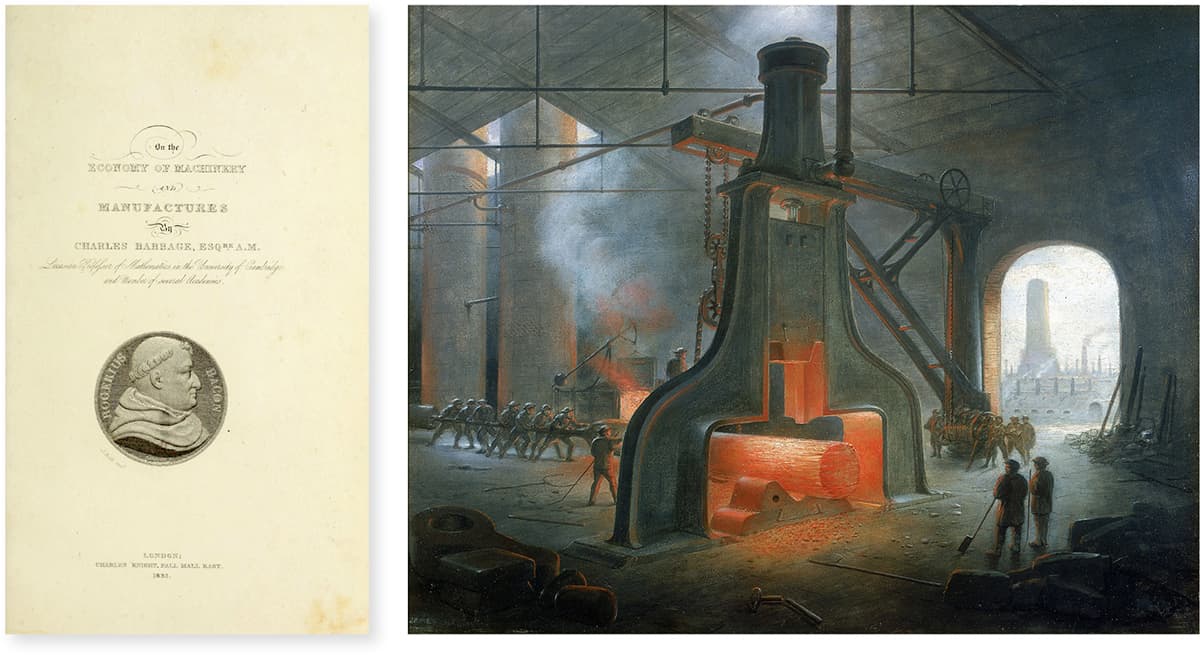
Charles Babbage
ON THE ECONOMY OF MACHINERY AND MANUFACTURES, CHARLES KNIGHT, 1832
The title page of Babbage’s book on organizing manufacture alongside James Nasmyth’s painting of his own steam hammer, erected in his foundry near Manchester in 1832.
Sadi Carnot
RÉFLEXIONS SUR LA PUISSANCE MOTRICE DU FEU, BACHELIER, 1824
The title and interior pages from Carnot’s book that marked the beginnings of thermodynamics, including a table of specific heats of gases. Housed in the Bibliothèque nationale de France.
A good friend of Babbage’s also published some significant works at around the same time. This was John Herschel, the son of the man who discovered Uranus, William Herschel. John, born in the English town of Slough in 1792, allegedly inspired Babbage’s computer work. The story goes that Babbage was helping Herschel painstakingly construct a table of numbers, when he cried out, ‘My God, Herschel, how I wish these calculations could be executed by steam!’ Herschel wrote a number of important astronomical titles, notably A Treatise on Astronomy, and (amusingly, given Babbage’s complaint) produced a major update of his father’s astronomical catalogues.
However, John Herschel’s most significant book was A Preliminary Discourse on the Study of Natural Philosophy, which was an attempt to give a more modern synthesis of the scientific method than the earlier work of Bacon and others. Strictly, this wasn’t a book in its own right but appeared in 1831 as part of Lardner’s Cabinet Cyclopaedia. This publication was not, as it sounds, a single encyclopaedia, but rather a curated library of titles, of which Herschel’s was volume 14 of 133.
Shaping the modern world
The visual élan that was so central to the success of Birds of America would also be significant in a work that made important advances in scientific theory in the world of geology. In writing Principles of Geology, the Scottish geologist Charles Lyell was aiming at an academic audience, and yet the three-volume book proved a hit with the wider public, in part because of its illustrations. Lyell, born into a wealthy family near Kirriemuir in Angus in 1797, trained as a lawyer, but within a few years was occupied full-time by his interest in geology. He cemented his place in the field with the publication of Principles of Geology, which came out a volume at a time between 1830 and 1833.
Looking at the topic with modern eyes, geology does not seem like a subject that is likely to inspire much interest in the public. However, at the time, geology was a controversial field of significant public interest, worthy of newspaper headlines. This was because the latest theories, supported and expanded by Lyell, overthrew the long-held ideas on the age of the Earth, based on biblical calculations. The central idea espoused by Lyell was known as ‘uniformitarianism’, originally developed by the Scottish geologist James Hutton. Up until this time, it was accepted that the Earth had been shaped by a series of catastrophes, such as the biblical flood, forming its current geography with a timescale calculated from the genealogical lists in the book of Genesis, starting from Noah, based on estimated lifespans. This put the date of the creation of the Earth at 4004 BCE. By contrast, uniformitarianism made it clear that the mountains and valleys formed by very gradual, continuous processes, which would have taken millions of years to complete.
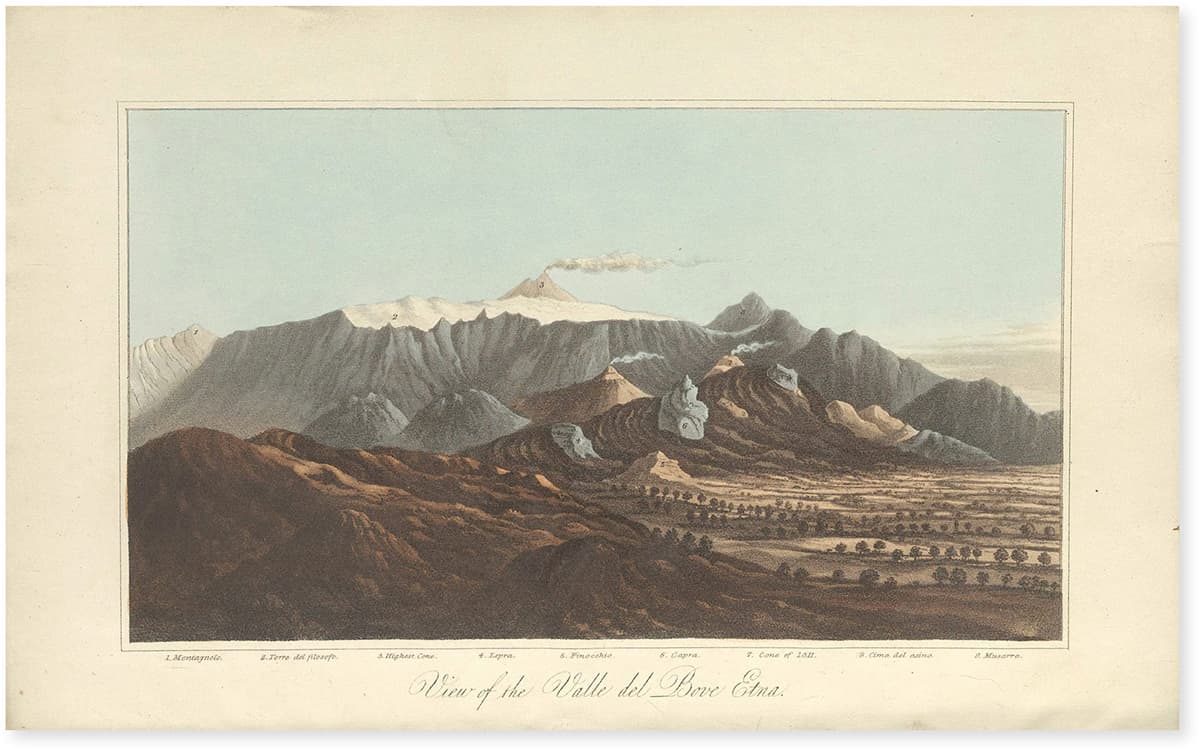
Charles Lyell
PRINCIPLES OF GEOLOGY, JOHN MURRAY, 1832
The frontispiece to volume two of Lyell’s influential work, showing the region around Mount Etna in Sicily. The book was published in three volumes between 1830 and 1833.
Charles Lyell
PRINCIPLES OF GEOLOGY, JOHN MURRAY, 1830
Interior pages from volume one of three, published between 1830 and 1833. Lyell’s description of the impact of the 1783 Calabrian earthquake demonstrates his use of illustrations to engage the reader.
Lyell made the details of this theory widely available in Principles of Geology, inspiring a young Charles Darwin (see here) to think about the implications of these geological timescales for biological species. Not only was Darwin given a copy of the first volume of the book, he was asked by Captain Robert Fitzroy of the HMS Beagle – the ship on which he made his famous voyage – to help look for geological formations for Lyell. Later, Darwin and Lyell would become friends.
It is worth noting the full title of Lyell’s book: Principles of Geology: being an attempt to explain the former changes of the Earth’s surface, by reference to causes now in operation. A significant inspiration for the new approach referred to in the title was to take note of the movements of the Earth’s surface caused by the likes of volcanoes and earthquakes and consider the long-term implications of such shifts and displacements.
As the discipline of geology advanced, uniformitarianism alone would prove unsatisfactory. One of the main criticisms at the time was evidence of what we now call mass extinctions in the fossil record, which was gradually becoming understood. These mass extinctions, we now know, are indeed the result of sudden, catastrophic changes, but are the exception rather than the rule in shaping the surface of the planet.
Charles Lyell
PRINCIPLES OF GEOLOGY, JOHN MURRAY, 1833
A range of types of fossilised shell used in helping to comparatively date different geological layers. These are from Lyell’s third and final volume.
Alexander von Humboldt
KOSMOS, KRAIS & HOFFMANN, 1851
An illustration of the Earth from von Humboldt’s popular title.
Alexander von Humboldt
KOSMOS, KRAIS & HOFFMANN, 1851
A range of illustrations from von Humboldt’s title, demonstrating its mix of geophysical (opposite), meteorological (top) and astronomical (bottom) material.
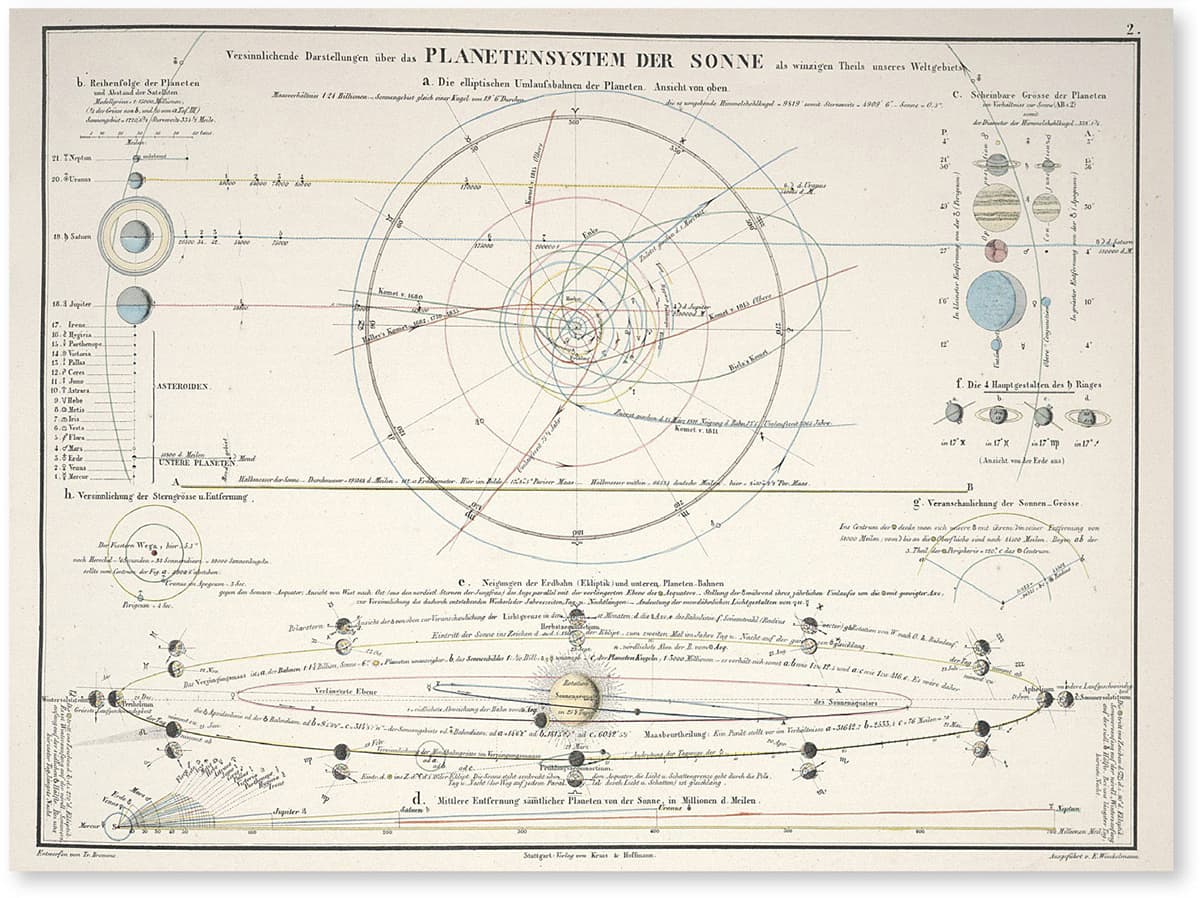
Alexander von Humboldt
KOSMOS, KRAIS & HOFFMANN, 1851
Another illustration from Kosmos, showing world times corresponding to midday in Dresden, reflecting the lack of established time zones, with each city operating on its own time.
While on the subject of geology and geophysics, it is worth mentioning another book, published a little later, with five volumes coming out between 1845 and 1862. This was Kosmos (Cosmos) by the German scientist Alexander von Humboldt, born in Berlin in 1769. Like Principles of Geology, Kosmos was a hugely popular title in its day, having an appeal far outside the specialists in the area.
Kosmos was based on a series of lectures that Humboldt gave – the closest the period had to the sweeping multi-part science documentaries we now see on television. Although strongly influenced by his expeditions, Humboldt attempted, in Kosmos, to provide a holistic picture of the order and structure of the universe, reflected in the Earth. It was Humboldt who, through this book, brought the word ‘cosmos’ into modern usage – until then it was an obscure Greek word that few would have known. In some ways, Humboldt’s book had similarities with Bronowski’s The Ascent of Man (see here), published over a hundred years later. Kosmos brought together concepts of the order of nature and of human interpretation and appreciation of beauty. It was both an exploration of the physical universe and of the history of our attempts to understand and appreciate nature.
Humboldt’s name is probably most frequently associated with his exploration work. Between 1799 and 1804, Humboldt explored the Americas, bringing back many drawings and accounts of his findings on the flora and fauna (notably an encounter with electric eels) that would find their way into a range of volumes, including Essai sur la géographie des plantes (Essay on the Geography of Plants), Ansichten der Natur (Views of Nature), and his popular Voyage aux Regions Equinoxiales du Noveau Continent (Travels to the Equinoctial Regions of the New Continent).
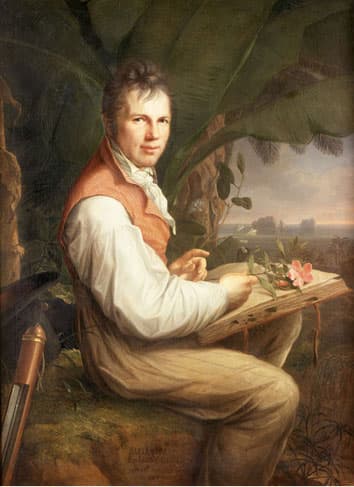
Friedrich Georg Weitsch
ALEXANDER VON HUMBOLDT, CA. 1806
A portrait of Alexander von Humboldt, German naturalist and geographer.
The beauty of biology
One of Lyell’s most vocal challengers on uniformitarianism was an early expert on fossils, who authored an important biology text. His name was Georges Cuvier, later Baron Cuvier as he was made a life peer by the French state. Born in Montbéliard near the Swiss border in 1769, Cuvier was, scientifically speaking, most successful in his work on palaeontology, which related the limited fossil record known at the time to animals that were still in existence. But his best-known title was a wide-ranging book that tried to categorise all animals into a single structure: Le Règne Animal (The Animal Kingdom).
This four-volume work, published in 1817, could be seen as an illustrated equivalent of Linnaeus’s Systema Naturae with the benefit of nearly 100 years of additional collected information on animals. This enabled Cuvier to produce a more accurate taxonomic structure based on similarities and differences in the animals’ anatomy, with the addition of his own experiences from palaeontology. Cuvier got a lot right, considering the crudeness of his method of using visual similarities, though he did have a few stumbling blocks. As well as rejecting uniform geological changes, Cuvier could not accept the principle of evolution, even though in his use of comparative anatomy he made, for example, the connection between the extinct mammoth and the modern elephant. Whatever its conceptual faults, however, Le Règne Animal was an impressive effort and a visual delight.
Georges Cuvier
LE RÈGNE ANIMAL, FORTIN, MASSON ET CIE, 1836–49
Some of Cuvier’s elegant illustrations comparing similarities and differences in related species in a later coloured edition, published 19 years after the original publication in 1817.
Cuvier’s book was eclipsed in size by an earlier work by another French nobleman, Georges-Louis Leclerc, Comte de Buffon. Buffon’s massive Histoire Naturelle, générale et particulière, avec la description du Cabinet du Roi (General and Particular Natural History, with a description of the King’s Cabinet) ended up 36 volumes long (another eight were later added), written over his working life from 1749 to 1804. This was far more a descriptive work than an attempt to apply a scientific structure to animal classification and was something of a rag bag. While it included elements of physics, chemistry and geology as well as natural history, it excluded, for example, animals other than quadrupeds and birds. This random selection had something in common with the Cabinet du Roi of the title – the King’s ‘cabinet of curiosities’ that was an unstructured collection of interesting looking items collected from around the world.
In itself, the Histoire Naturelle probably could not be considered a great science book (even at the time it was criticised for a florid writing style and lack of scientific depth, being arguably aimed more to impress the general reader than the natural philosopher), but it would have a significant impact on more important scientific writers such as Cuvier, and it was well illustrated for the time, including nearly 2,000 plates.
Another influential science writer from the period deserving a mention (even though Cuvier seems to have pretty much ignored him) is Jean-Baptiste Lamarck. Born in Bazentin in 1744, the French biologist developed an early (but mistaken) evolutionary theory. Lamarck’s idea was that, for example, a giraffe might develop a longer neck during its lifetime as a result of continually stretching to reach for leaves in the trees. This development, he believed, could then be passed on to the animal’s offspring. This idea of the inheritance of acquired characteristics was central to Lamarck’s most influential book, Philosophie Zoologique ou Exposition des considérations relatives à l’histoire naturelle des animaux (Zoological Philosophy, or Exposition with Regard to the Natural History of Animals), published in 1809.
Georges Cuvier
LE RÈGNE ANIMAL, DÉTERVILLE, 1817
Comparisons of skulls and fish in the original edition of Cuvier’s title.
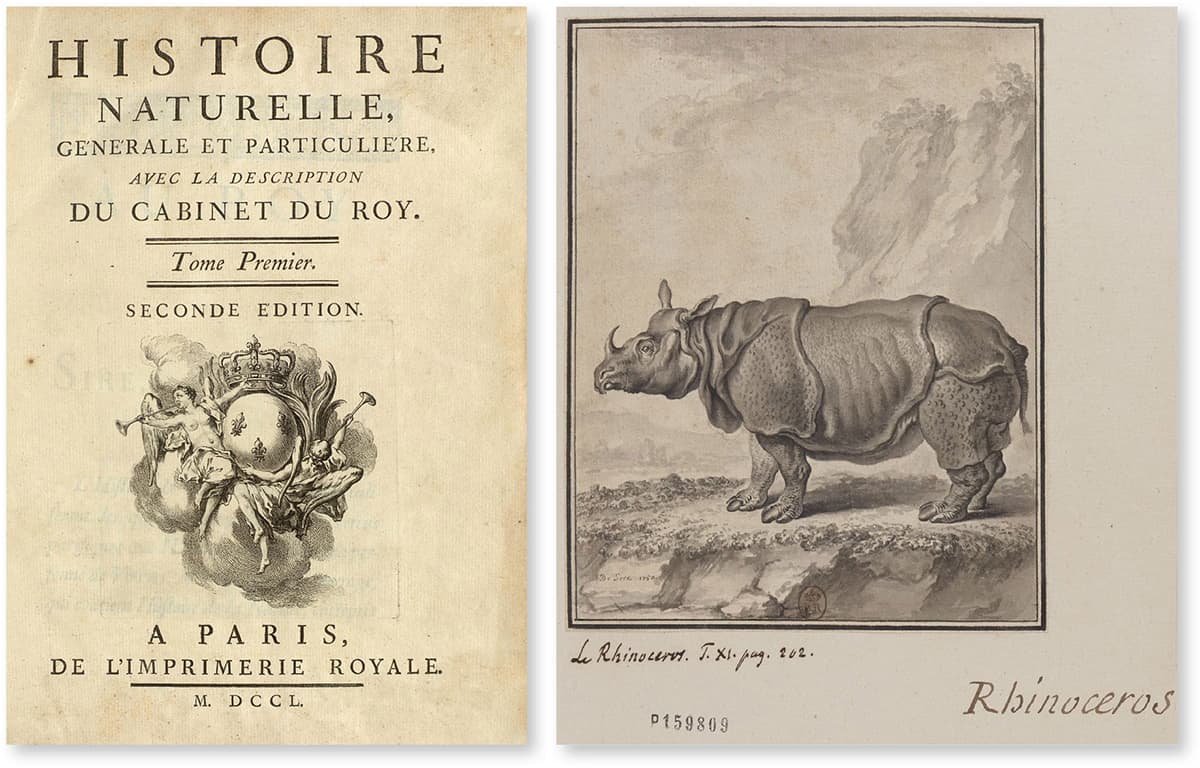
Comte du Buffon
HISTOIRE NATURELLE, IMPRIMERIE ROYALE, EIGHTEENTH CENTURY
The title page of the second edition of volume one published in 1750 and an illustration of a rhinoceros from volume four, ca. 1763, housed in the Bibliothèque nationale de France.
Lamarck’s concept of the inheritance of acquired characteristics would be killed off by the later theory of natural selection and by advances in the understanding of genetics. This meant that for a long time, his work was dismissed. However, modern biology recognises that there are aspects of epigenetics – the way that genes are repeatedly switched on and off by external influences – that can be modified by the environment and passed on to a living thing’s descendants. Although, as we have seen, the basis for Lamarck’s theory was incorrect, he did at least realise the importance of both adaptation to the environment and survival of the fittest.
In this sense, Buffon and Lamarck were both ahead of Cuvier in their ideas, being more supportive of the ideas of the development of species that would lead to the writing of one of the most influential science books ever produced. Before turning to Charles Darwin, however, it’s interesting to look at a book which he himself credited with helping to pave the way for the acceptance of his theory of evolution by natural selection. The title in question was Vestiges of the Natural History of Creation. Published in 1844, it was an international bestseller, no doubt helped by the revelation that Prince Albert was said to have read it aloud to Queen Victoria. The book was originally anonymous: it was 40 years later that the author was revealed to be Peebles-born Scottish author and publisher Robert Chambers.
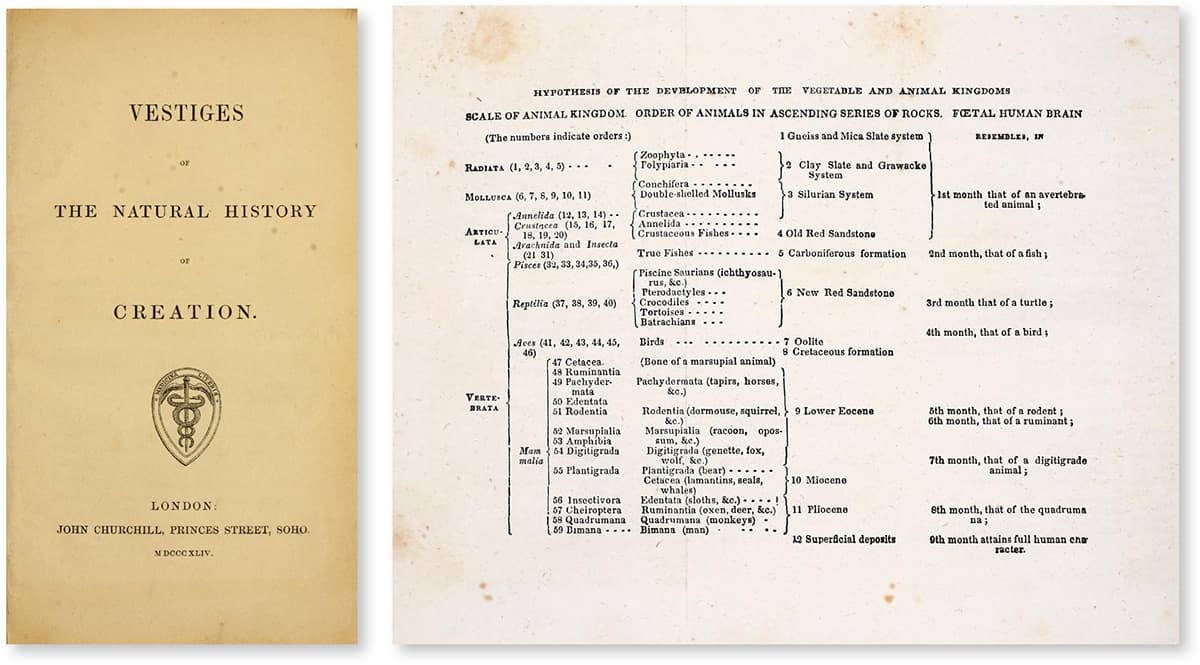
Robert Chambers
VESTIGES OF THE NATURAL HISTORY OF CREATION, JOHN CHURCHILL, 1844
The title page from the first edition and a table from an 1858 American edition (published by Harper & Brothers) linking animals with rocks thought to date from a similar period.
Vestiges takes a big-picture approach, starting with the idea of stellar evolution to show how everything has developed over time from earlier instances. In its picture of natural and continuous change, Vestiges was at odds with creationist views, but was nonetheless respectable as it didn’t have any suggestion of an atheist agenda. Some aspects of the science in the book were old-fashioned even by the ideas of the time – Chambers supported both Lamarck’s theory of the inheritance of acquired characteristics and the idea of spontaneous generation, for example, where living things were thought to emerge from rotting meat and other substances. But there is no doubt that it had a powerful impact.
Evolving science writing
In 1859, what is probably the best-known science book ever written arrived on the scene. The book was On the Origin of Species by Means of Natural Selection, or the Preservation of Favoured Races in the Struggle for Life by Charles Darwin. Origin of Species was the book that introduced the concept of evolution by natural selection to the general public. Though, as we have seen, aspects of the concept itself had been debated for a couple of generations, it was Darwin who presented the whole picture for the first time.
This was very much an idea that was in the zeitgeist. With hindsight, evolution by natural selection may seem obvious. Anyone with an understanding of the basics of science, presented with the way that genetic information is passed on from generation to generation would expect that some offspring would be better suited to survive than others, and those with the preferred genetic modifications would be the ones to produce further generations and pass on those adaptations. However, in Darwin’s day, that genetic model was not available, making the mental leap harder. As we have seen, though, ideas of evolution were already in the air in Darwin’s grandfather’s time (see here), and by the time Darwin was working on his theory others were hot on his heels, notably another English naturalist, Alfred Russel Wallace, who shared his very similar ideas with Darwin before Origin of Species was finished, and would jointly publish papers with Darwin.
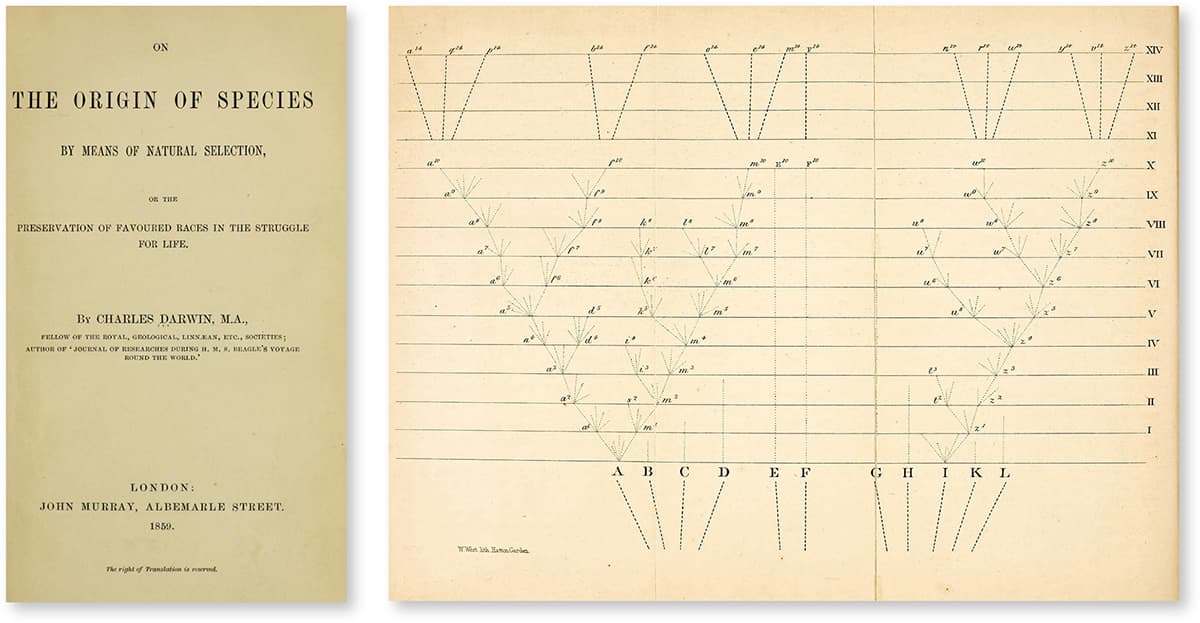
Charles Darwin
ON THE ORIGIN OF SPECIES, JOHN MURRAY, 1859
The title page of Darwin’s famous book with the only illustration in the original, a lithographic diagram by William West of a tree of descent based on degrees of similarity.
FINCHES FROM GALAPAGOS ARCHIPELAGO, 1890
Galapagos finches showing varied beaks from a later publication of Darwin’s Beagle journals (first published in 1839) alongside a photograph by Julia Margaret Cameron from 1868 of Darwin aged 59.
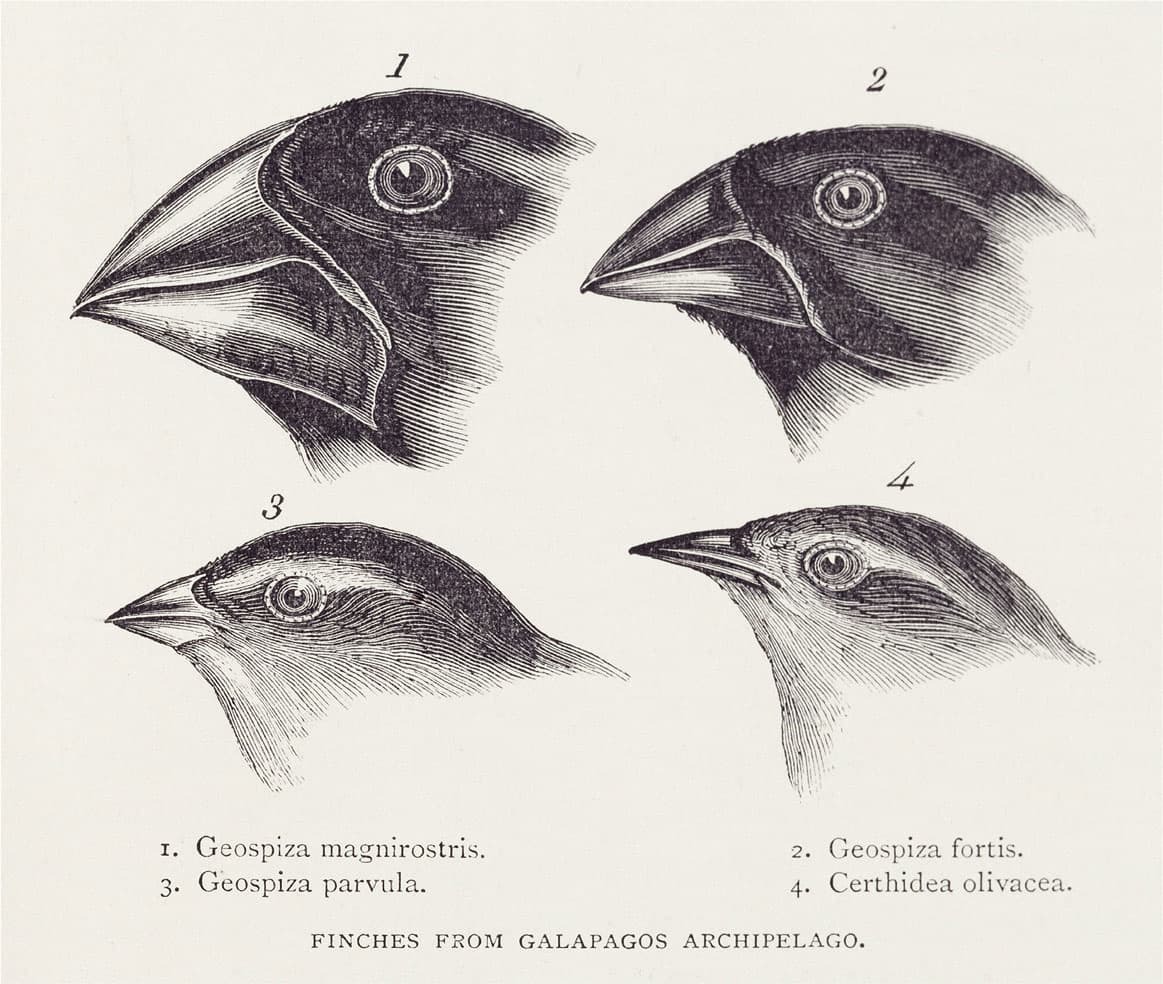
Born in Shrewsbury, England, in 1809, Darwin originally trained as a doctor before his interest in natural history pushed his studies aside. Famously, the event that cemented his position in history was being invited to be a naturalist and companion of captain Robert FitzRoy on his HMS Beagle voyage. Lasting almost five years, this epic journey exposed Darwin to a huge range of wildlife, from the marsupials of Australia to the finches of the Galapagos Islands. It was Darwin’s observation of these birds and the way in which they had markedly diverged on neighbouring islands with different environments, that would prove one of the inspirations for writing Origin of Species.
It took Darwin over 20 years from first considering the ideas of evolution (the Beagle returned to England in 1836) to publishing Origin of Species in 1858. His thinking was advanced by meetings with the likes of Lyell and with those who had studied fossil bones, such as anatomist and palaeontologist Richard Owen. One of the reasons the gestation of the book was so long was that Darwin’s work on evolution was something he used to fill in time, rather than being his central activity. After writing accounts of the Beagle voyage (notably Journal and Remarks, published in 1839, usually referred to as The Voyage of the Beagle) and books on the flora and fauna he had encountered, Darwin was distracted by a near-obsession with barnacles. But the arrival of a letter from Wallace that contained an idea very similar to Darwin’s own firmly pushed Darwin into completing his masterpiece.
Once published, the book proved popular and, considering how much debate it still generates in some parts of America, was surprisingly lacking in controversy in its early days. With time, debates on the topic (not involving the self-effacing Darwin) became more vocal, most notably after the infamous Oxford ‘debate’ in 1860. More a discussion than a strict debate, this involved a number of supporters of Darwin, including Robert FitzRoy, but has come to be best remembered for the verbal sparring between a highly vocal Darwin enthusiast, Thomas Huxley, and the bishop of Winchester, Samuel Wilberforce. Wilberforce asked Huxley if he was happy to have a monkey or ape as a (great) grandparent (the exact wording is uncertain as there was no word-for-word account), a jibe Huxley effortlessly put down.
Surprisingly, there seems to have been less negative reaction still to Darwin’s follow-up title, published in 1871, The Descent of Man, and Selection in Relation to Sex. This focused on the human implications of evolutionary theory and brought in an additional selection mechanism to natural selection in the form of sexual selection. The lack of negative reaction seems to have been because, despite the popularity of the book, the implications of evolution for the origins of humanity had been argued thoroughly in the previous decade and more. The idea that humans had not been created as they were, with no antecedent species, had lost the power to shock. Only the aspect of sexual selection – the idea that animals could keep changes that would be disadvantageous under natural selection because they made mating more likely, such as the peacock’s tail – was a novelty, and was too technical to worry the general reader.
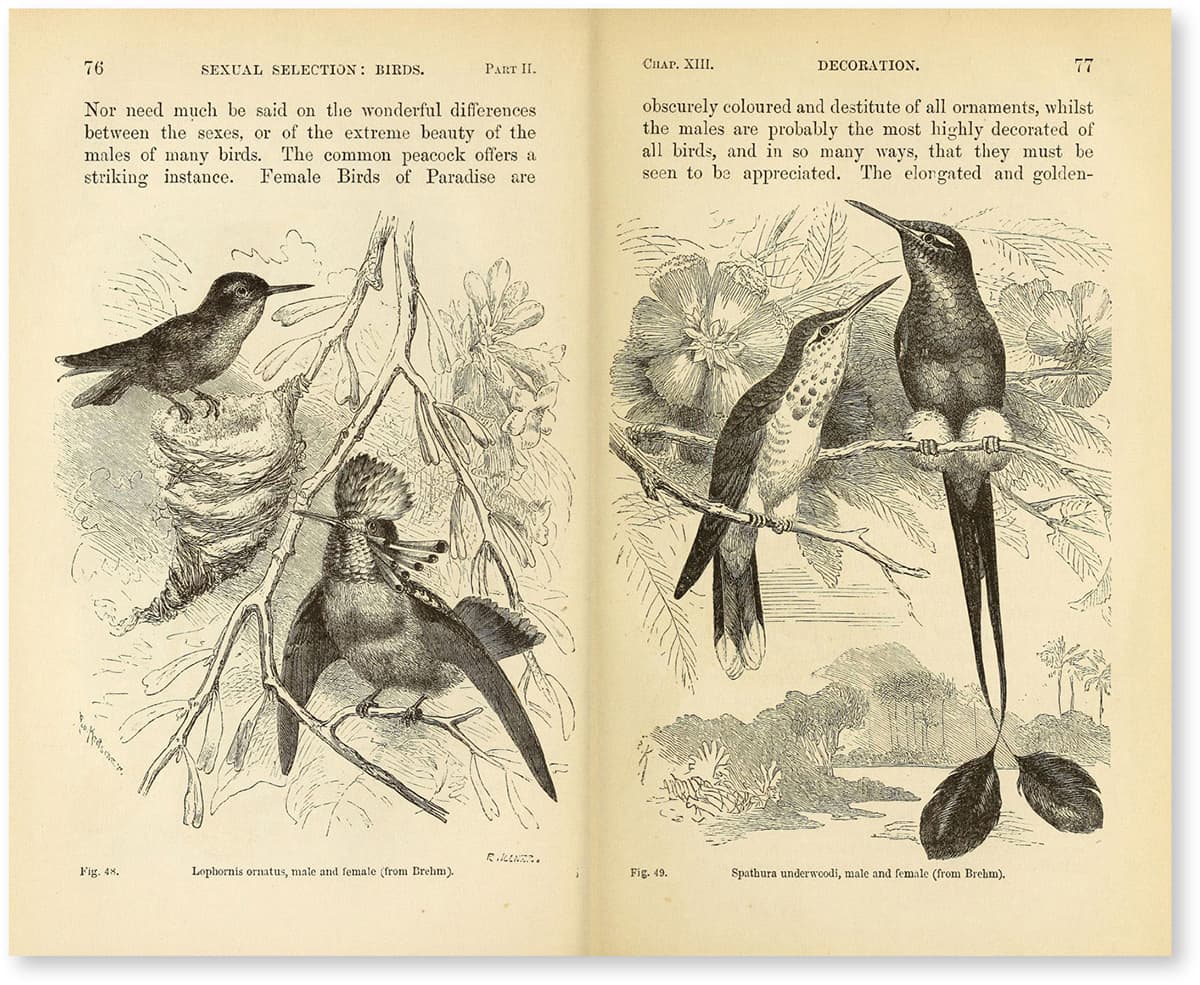
Charles Darwin
THE DESCENT OF MAN, JOHN MURRAY, 1871
Illustrated pages from the first edition of volume two of two, showing the deployment of colouration and extreme feather structures in sexual selection of birds.
Darwin’s last notable title, The Autobiography of Charles Darwin, was published in 1887, five years after his death. It was originally written for his children as Recollections of the Development of my Mind and Character and is surprisingly unstuffy for a piece of Victorian writing. Given the way that Darwin tends to be hero-worshipped (or demonised) today, The Autobiography is wonderfully self-deprecating in describing his path from enthusiastic slaughterer of game to amateur geologist and self-taught naturalist. The book doesn’t cover the Beagle voyage, but rather the way that Darwin tried to apply the same kind of scientific rigour that Lyell applied to geology and use Francis Bacon’s approach of collecting facts without hypothesis, before going further to his ideas on natural selection and evolution.
Genetics and the scientific paper
One thing Darwin definitely got wrong was his idea of how evolution took place on the microscopic level, assuming that it involved some kind of blending of the natures of an animal’s parents. He would have benefited hugely if he had been able to read Versuche über Pflanzenhybriden (Experiments on Plant Hybridisation) by Gregor Mendel. Strictly speaking, this was an academic paper rather than a book, only running to around 50 pages, though it was subsequently published in book form with additional material.
In effect, Mendel’s work was the missing piece of the jigsaw that Darwin never found. Gregor Mendel was an Austrian friar, born in 1822 in Heinzendorf bei Odrau (now in the Czech Republic). By cross-breeding pea plants with different traits, such as height and flower colour, Mendel discovered that there were factors that we would now call genes that determined the way these traits were inherited in future generations. This was the mechanism necessary for Darwin’s evolutionary theory to work.
Unfortunately for Darwin and his colleagues, Mendel’s work, published in 1866 in the proceedings of an obscure natural history society, had no impact until it was rediscovered in the early twentieth century. Since then, Versuche über Pflanzenhybriden has been criticised as the results are simply too close to Mendel’s expectations – he may have shaded the results to match his theory. However, whether or not this was the case, Mendel’s text deserves a special place in the history of science writing.
Versuche über Pflanzenhybriden reflects the change in the way that scientists communicated with each other, which accelerated in the nineteenth century. The idea of scientific papers published in journals grew out of letters exchanged between scientists. In an age of email and social media, it’s easy to forget how important letter writing was in past times. A small illustration of this is that the Post Office in Scotland decided to place a postbox on the entrance to the scientist James Clerk Maxwell’s country estate for his use, so large was the flow of correspondence between Maxwell and his colleagues.
With the foundation of scientific societies, such as the Accademia dei Lincei in Rome in 1603 and the Royal Society in London in 1660, these institutions became hubs for the exchange of scientific information. This was often in the form of letters, funnelled through the society’s secretary, but increasingly became focused on their publications. The Royal Society started the world’s first scientific journal, Philosophical Transactions (still in print today), in 1665, bringing with it the idea of peer review, whereby other natural philosophers would provide appropriate criticism of the content before publication.
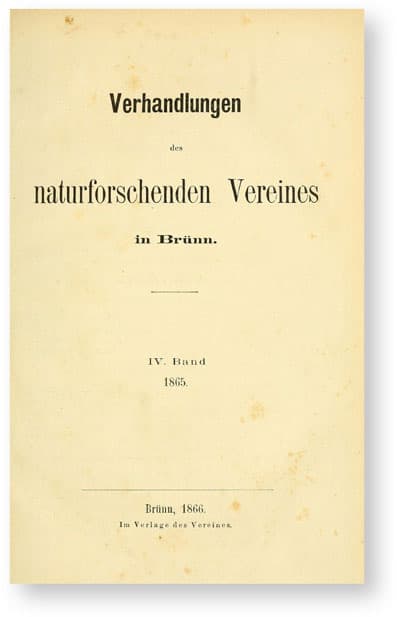
Gregor Mendel
‘VERSUCHE ÜBER PFLANZENHYBRIDEN’, VERHANDLUNGEN DES NATURFORSCHENDEN VEREINES IN BRÜNN, 1866
The 1866 copy of the Proceedings of the Natural History Society of Brünn, which carried Mendel’s largely overlooked paper.
Baden Powell
A GENERAL AND ELEMENTARY VIEW OF THE UNDULATORY THEORY, JOHN W. PARKER, 1841
Spectral charts (left) from Powell’s experiments which were first published in Philosophical Transactions before being collected together in a book on the mathematician’s work on optics.
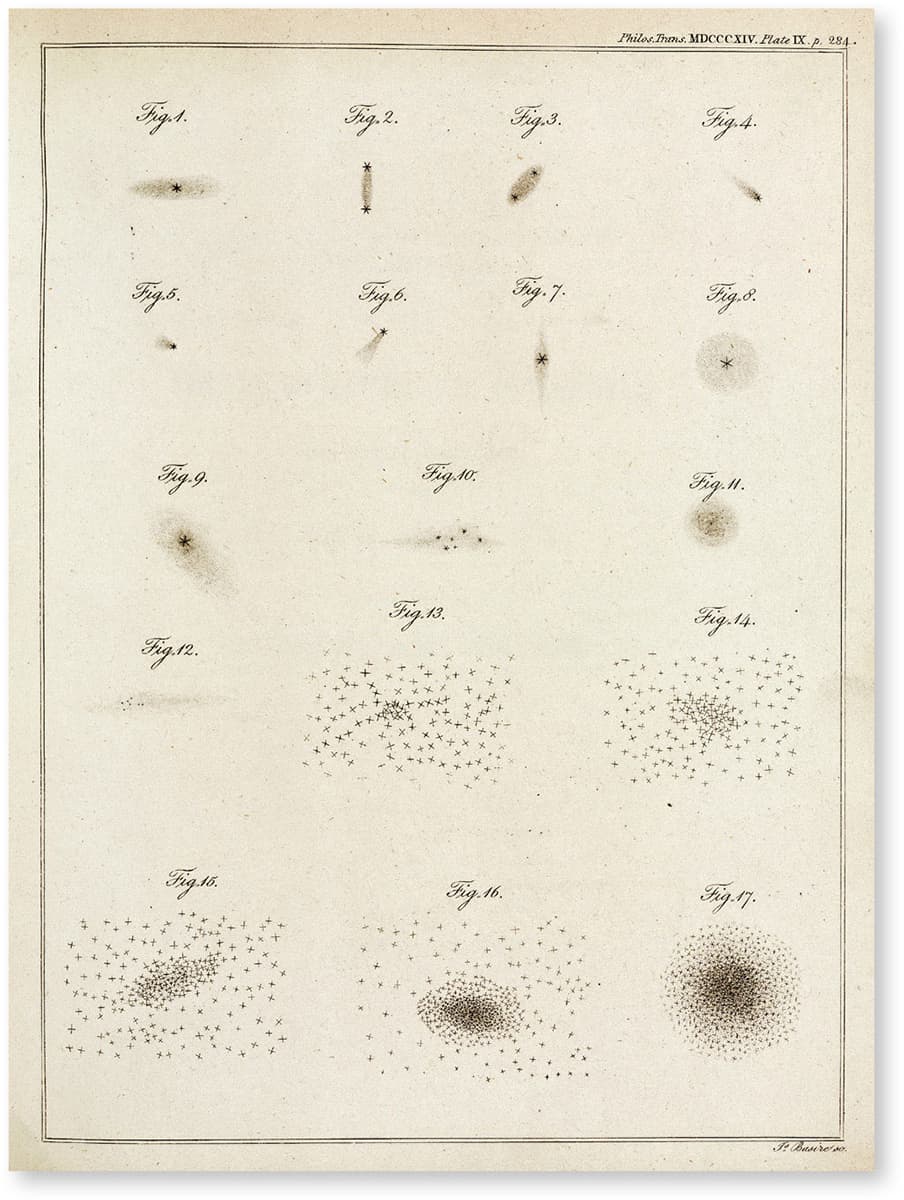
William Herschel
‘ASTRONOMICAL OBSERVATIONS RELATING TO THE SIDEREAL PART OF THE HEAVENS’, PHILOSOPHICAL TRANSACTIONS OF THE ROYAL SOCIETY OF LONDON, VOL. 104, 1814
Image above of nebulae accompanying an article by Herschel in Philosophical Transactions.
Such journals, published both by academic institutions and private publishing companies, flourished and multiplied. Getting a paper published in a journal was a far quicker process than completing a book and getting that to press. So successful were journals that, with time, it became increasingly difficult to keep on top of the sheer volume of publications. Some attempt was made through abstracts. The idea was to write a very short summary of a paper which would be abstracted into a separate publication, providing a top-level summary of current developments, enabling someone interested in reading more on a particular topic to then request the full paper. But it still was all too easy for a paper in an obscure publication to be overlooked, as Mendel discovered.
As the rate of scientific discovery took off, it became natural to share ideas via journals, making it less necessary for scientists to go to the effort of writing books. The peer-to-peer communication of the academic scientific book would never entirely disappear, but it would become far less essential for scientists’ work to be recognised.
From logic to anatomy
Writing at the same time as Darwin were two leading mathematicians, George Boole and John Venn, whose books were highly influential in their field. They are now largely remembered for a symbolic approach to logic that is central to the workings of computers and to simple diagrams that illustrate logical connections. Boole, born in Lincoln in 1815, was the first into the fray with a book called An Investigation of the Laws of Thought on Which are Founded the Mathematical Theories of Logic and Probabilities, published in 1854. Since ancient Greek times, logic had been a matter of words, but Boole brought to it the symbolic tools of mathematics. The result, ‘Boolean algebra’, is at the heart of the way that gates – the fundamental logical components of computers – work, and is in action every time we type a search term into a computer.
As for John Venn, born in Hull in 1834, his first important book was The Logic of Chance from 1866, which was a major work in the development of the ideas of probability. Venn’s mathematical approach to the probability of something happening was based on the number of times such an event would occur if you had a very large number of trials. This was probably Venn’s more significant contribution to mathematics, although he is better remembered for Venn diagrams, which first appeared in his 1881 book Symbolic Logic. These familiar diagrams use shapes to illustrate relationships in Boolean algebra. Typically, they feature two or more overlapping circles within a space. Depending on where an item is placed within the space, the circles it occupies show the logical combination of properties assigned to it.
Just as Venn diagrams and Boolean searches are familiar terms today, so too is the title of what remains probably the best-known medical textbook of all time, Gray’s Anatomy – thanks in part to the popular US television drama of the same name. First published in 1858, updated versions of Gray’s Anatomy are still in print.
George Boole
AN INVESTIGATION OF THE LAWS OF THOUGHT, DOVER PUBLICATIONS, 1854
The title page of the book in which Boole introduced Boolean algebra – a notation for the mathematical representation of logic.
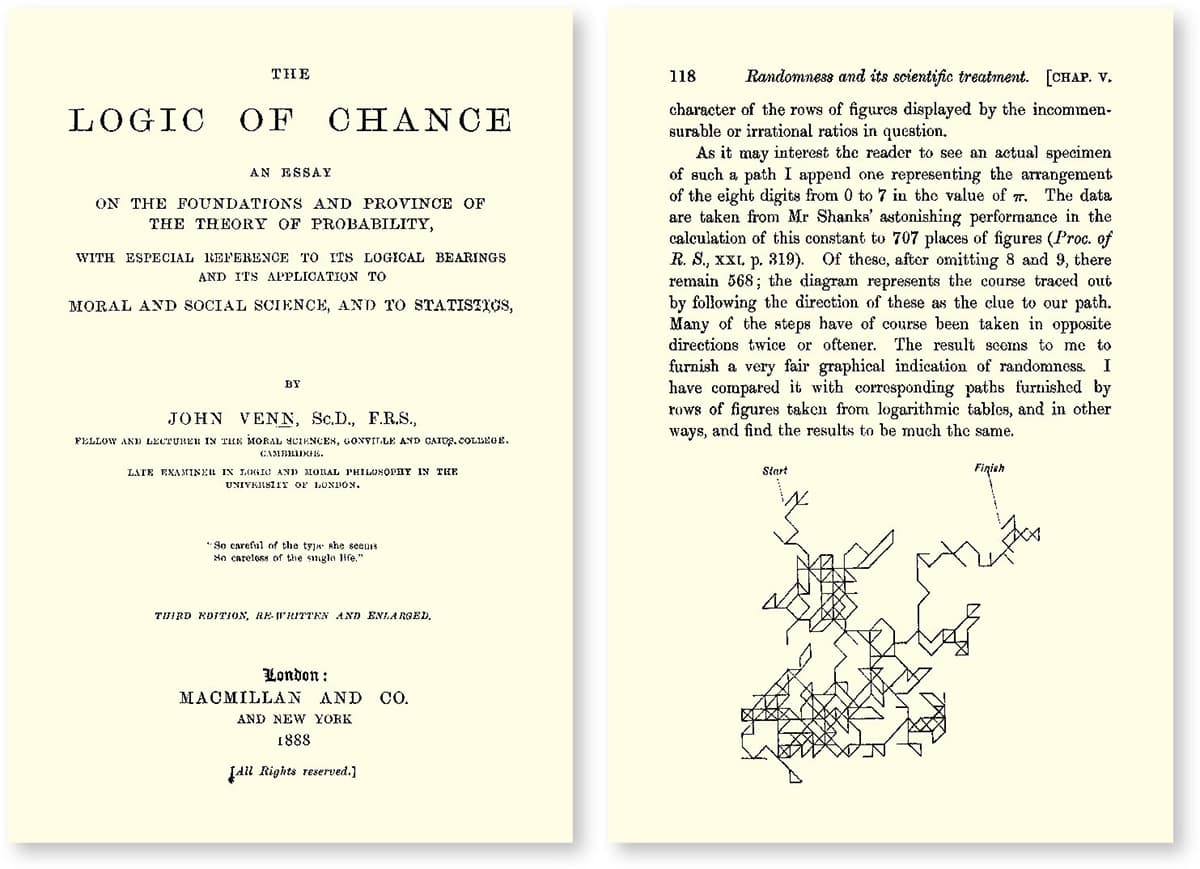
John Venn
THE LOGIC OF CHANCE, MACMILLAN AND CO., 1888
The title page and an illustration of a ‘drunkard’s walk’ or random walk from the third edition of Venn’s important book on probability, first published in 1866.
Henry Gray
ANATOMY, JOHN W. PARKER & SON, 1858
The title page and coloured anatomical illustrations from Gray’s famous book.

Henry Gray was an English surgeon, born in London in 1827. Historically, surgeons had been considered very much second-rate to physicians, members of a profession that began as little more than barbers with a small amount of ad-hoc practical experience of human anatomy. However, just as professional science was beginning to take off, so the idea that the practice of surgery could be given more of a scientific basis was also coming into vogue. Working with his accomplished illustrator, also a surgeon, Henry Vandyke Carter, Gray worked through a series of dissections of human bodies in the process of writing the book. Sadly, Gray lived only three years from the first publication of the book, contracting smallpox while treating his own nephew and dying aged just 34. As a result, the vast majority of the extant copies of Gray’s Anatomy owe as much to other authors as they do to Gray. However, his name will always be linked to this definitive medical title.
This was an important period for medical work. Just three years after Gray’s Anatomy first appeared, another book was published, marking the work of a man whose observations saved the life of many women in childbirth. This was Die Ätiologie, der Begriff und die Prophylaxis des Kindbettfiebers (The Causes, Description and Preventative Treatment of Childbed Fever) by the Hungarian physician Ignaz Semmelweis, born in Buda in 1818. In Europe at the time, the number of women dying of what we now know were infections of the reproductive tract had shot up. In the worst cases around four in ten women would not survive the period around childbirth.
Semmelweis believed that the extremely high levels of mortality were due to the doctors, who were examining women without handwashing, and often went from woman to woman in a maternity ward. He recommended handwashing between examinations using antiseptic, which when applied drastically reduced the deaths. This wasn’t an entirely new idea – Scottish doctor Alexander Gordon had written a treatise with the same conclusion as early as 1795, for example – but it was Semmelweis who systematically investigated the problem, trying out different approaches at Vienna’s General Hospital from around 1847.
By the time Semmelweis published his book in 1861, he had excellent evidence that the increase in fatalities had coincided with the introduction of regular internal examinations and that doctors washing their hands with a chlorinated solution made childbirth much safer. Sadly, Semmelweis was mocked by many in the medical profession and his ideas were initially largely rejected in continental Europe. He suffered from increasing mental health issues, dying of an infected wound in an institution in 1865. It would be decades before Semmelweis’s ideas were fully adopted, though thankfully many physicians felt there was little harm to be had from the handwashing, and as a result, infection levels fell rapidly from the 1860s.
The book of the lecture
We started this chapter with a mention of one of the nineteenth century’s greatest scientists, Michael Faraday. As we have seen, Faraday came from a poor family; born in London 1791, he started his working life as a bookbinder’s apprentice and had a limited formal education. Perhaps because of this, although a number of books bear his name, the majority are either collections of his scientific papers or write-ups of his popular lectures from the Royal Institution. One of these, particularly worthy of note as a landmark example of early popular science, was The Chemical History of the Candle.
Published in 1861, this consisted of transcripts of six lectures given by Faraday in 1848, one of his contributions to the annual series of Christmas lectures for children which Faraday instituted and are still run today. Faraday’s idea was to use a simple candle as a starting point to look at what is happening in the flame, the results of burning, the nature of the atmosphere that allows it to burn and so forth. Faraday even includes in the book a number of experiments to try at home – the lecture series, as the Christmas lectures always have, would have featured a wide range of exciting demonstrations. Although The Chemical History of the Candle was not initially conceived as a book, the approach taken in its lightness of touch and consideration of a non-technical audience would set the scene for the development of more approachable popular science titles in the twentieth century.
It’s worth mentioning in parallel with Faraday’s work a series of three titles by an Irish physicist who was also mainly linked with the Royal Institution: John Tyndall. Born in Leighlinbridge in 1820, Tyndall is now best remembered for his explanation of why the sky is blue and for discovering the principle that would be used in fibre optics. But while Professor of Physics at the Royal Institution, Tyndall, like Faraday, was a great believer in the popularisation of science.
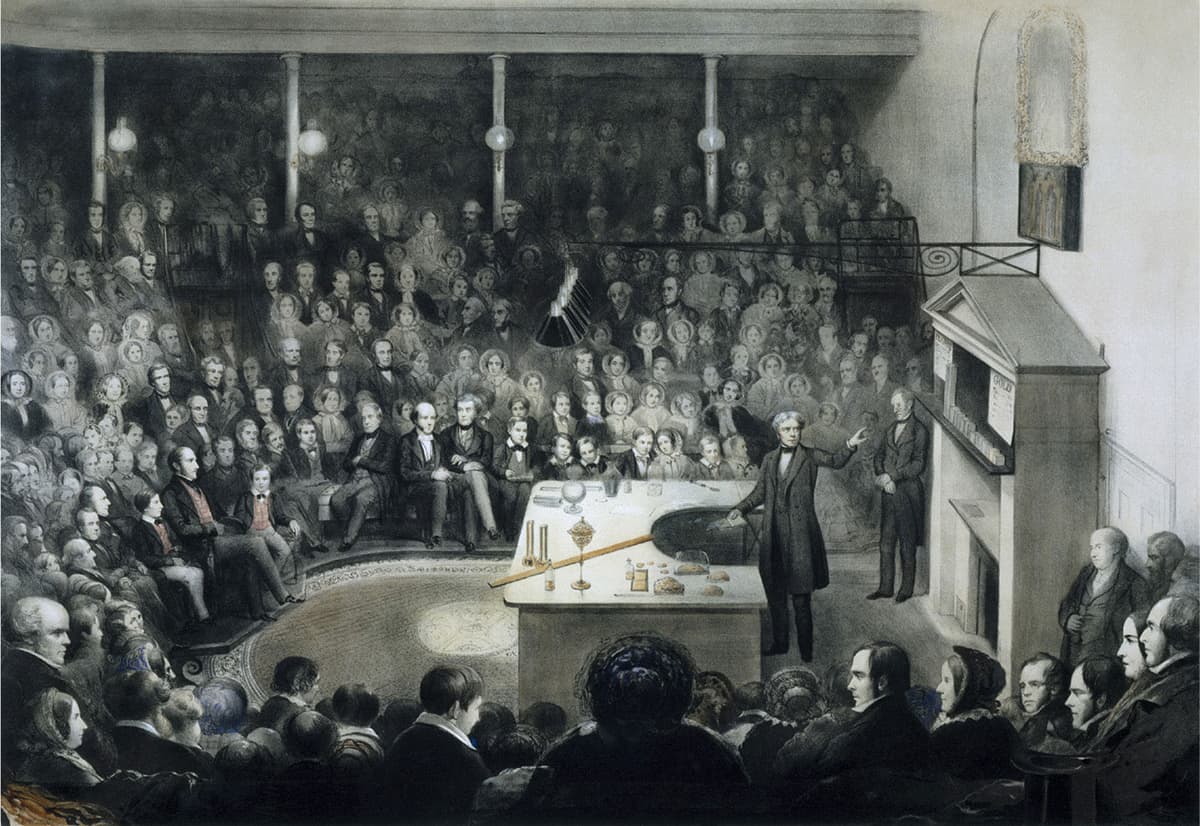
Leighton Bros
FARADAY AT THE ROYAL INSTITUTION, CA. 1855
A tinted lithograph after Alexander Blaikley, showing Michael Faraday giving one of the Royal Institution Christmas lectures to an audience including Prince Albert and his son.
Michael Faraday
THE CHEMICAL HISTORY OF THE CANDLE, HARPER & BROTHERS, 1861
Pages from Faraday’s ‘book of the lecture series’, showing the reduction in pressure as steam condenses and the collection of carbon dioxide from exhalation.
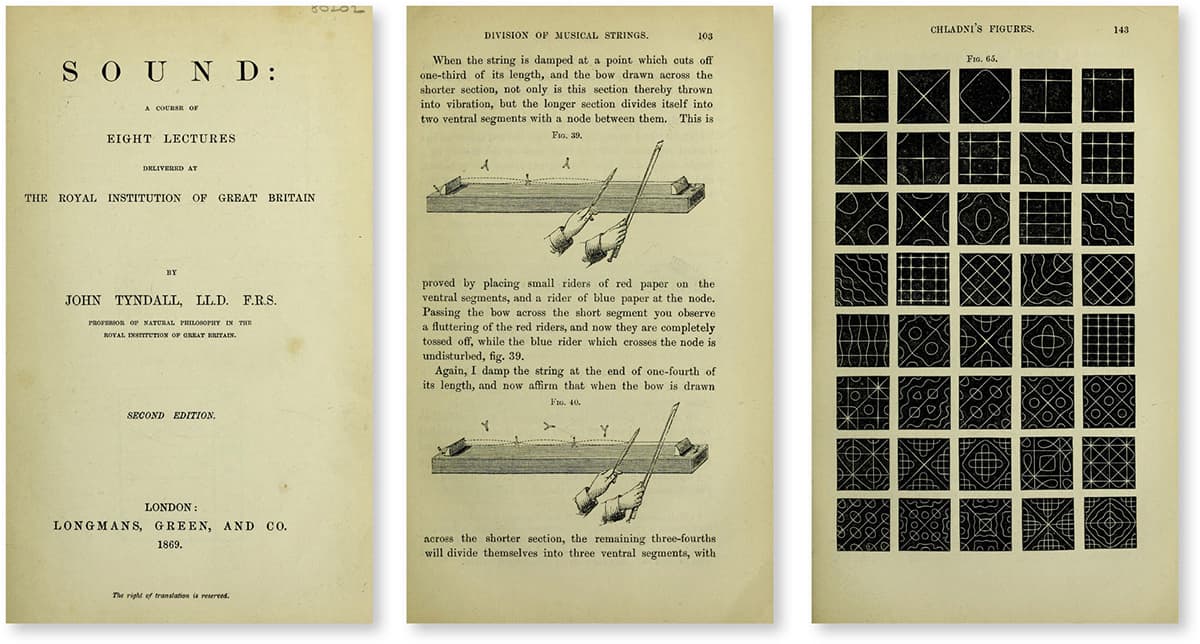
John Tyndall
SOUND, LONGMANS, GREEN, AND CO., 1869
First published in 1867, Tyndall’s Sound, like Faraday’s books, was based on his series of lectures at the Royal Institution.
In three ‘tutorial’ books, collecting material from lectures, Tyndall covered some of the most significant basic physics topics of the day: heat, light and sound. His aim was to make these topics approachable. As he says in the introduction to Sound: delivered in eight lectures from 1867: ‘In the following pages I have tried to render the science of Acoustics interesting to all intelligent persons, including those who do not possess any special scientific culture. … There is a growing desire for scientific culture throughout the civilised world. The feeling is natural, and, under the circumstances, inevitable. For a power which influences so mightily the intellectual and material action of the age, could not fail to arrest attention and challenge imagination.’ Sound was followed by Heat: a mode of motion in 1868 and Six lectures on Light in 1873. Although aimed at the general public, in each case, Tyndall tried as much as was possible to bring out the latest scientific thinking.
The master of electromagnetism
Michael Faraday in many ways acted as a precursor to one of the greatest physicists of the nineteenth century that few have heard of. Born in Edinburgh in 1831, James Clark Maxwell became a professor at the age of 25 and went on to have an impressive career, working both in universities and during breaks from academia in his home in Scotland. This culminated with his becoming the Cavendish Professor of Experimental Physics in Cambridge, where he set up the world-famous Cavendish Laboratory before his untimely death at the age of 48.
In his day, Maxwell was best-known for his work on statistical mechanics, explaining the actions of gasses through the statistical behaviour of molecules, as well as for work on the perception of colour, which led to him producing the colour model still used in colour televisions and computer screens today. His best-known book at the time was his Theory of Heat, first published in 1871. This is a textbook, but a relatively approachable one, spanning the gap between the academic and wider spheres, as the subtitle (‘Adapted for the use of artisans and students in public and science schools’) made clear.
However, Maxwell’s greatest work, and the most significant for future generations, was on electromagnetism. It was Maxwell who identified light as an electromagnetic wave, and he who, by developing first mechanical and then mathematical models of electricity and magnetism, was able to pull the two concepts together to produce a uniform whole, describing the action of electromagnetism by mathematics that would later be simplified down to four short equations. For physicists who have grown up with it, Maxwell’s mathematical modelling method was the natural approach to take – but for his contemporaries, even great physicists like his Scottish colleague Lord Kelvin, Maxwell’s abstracted theories were hard to understand, which was why it would not be until after his death that their greatness was truly appreciated.
For this reason, it is the Treatise on Electricity and Magnetism, published in 1873, two years after Theory of Heat, that is now regarded as by far Maxwell’s most influential piece of writing. It would continue to be used as a textbook well into the twentieth century, and was one of the reasons that Einstein said of Maxwell, ‘There would be no modern physics without Maxwell’s electromagnetic equations; I owe more to Maxwell than to anyone.’ Echoing Einstein, American physicist Richard Feynman commented, ‘From a long view of the history of mankind – seen from, say, ten thousand years from now – there can be little doubt that the most significant event of the nineteenth century will be judged as Maxwell’s discovery of the laws of electrodynamics.’ And the Treatise was Maxwell’s definitive word on the subject.
James Clerk Maxwell
TREATISE ON ELECTRICITY AND MAGNETISM, CLARENDON PRESS, 1873
A range of illustrations from Maxwell’s definitive title on electromagnetism, including the lines of force introduced by Michael Faraday.
At the borders of arts and sciences
With Maxwell as the zenith of nineteenth-century science writing, making mathematics central to physics in a way that had never been the case before, it’s timely to take a look at a less earth-shattering title that has nonetheless had lasting, if quirky appeal. This is Flatland: a romance of many dimensions by the unimaginatively named Edwin Abbott Abbott. Abbott, born in London in 1838, spent the majority of his career as a school headmaster. An ordained priest, he mostly wrote on the English language, but the slim volume that is Flatland, published in 1884, takes us on a journey into a two-dimensional world.
Although much of Flatland is a satire on social classes and mores, its descriptions of the interactions of two-dimensional shapes and the implications of living in a two-dimensional world, especially when a three-dimensional object appears in it, help the reader to get a feel for the mathematician’s approach to dimensions. Abbott even put a toe into the fourth dimension long before Einstein would use it in his work on relativity. To the modern reader, Abbott’s writing style is on the dull side, but the ideas contained in Flatland are still fresh.
Just as physics and maths books were taking steps forward towards the end of the nineteenth century, biology was also moving on in the hands of a biologist who took the work of Linnaeus and Cuvier, mixed in Darwin and brought natural history up to date. This was German scientist Ernst Haeckel, born in Potsdam in 1834. Although Haeckel was very much a contemporary of Maxwell in birth, his much longer life allowed him to publish into the twentieth century.
In some ways, Haeckel typified that insult ascribed to physicist Ernest Rutherford that all science is either physics or stamp collecting. His great contribution was primarily one of cataloguing, adding thousands of species to the Linnaean structure and coining a whole range of new terms from ‘ecology’ to ‘phylum’. Unlike his predecessors, however, Haeckel had Darwin’s work to build on, so he was able to construct one of the earliest family trees (literally in the form of a tree and branches) across animal species. Probably Haeckel’s best-known contribution to biological theory, which is now disregarded, was recapitulation theory. This was the idea that embryos pass through the different forms of their ancestral predecessor species before taking on the current form before birth. Nevertheless, Haeckel was hugely influential.
As well as being a scientist and philosopher, Haeckel was an impressively skilled artist, and his best-known work demonstrates not so much the breadth of his discoveries, but rather the effectiveness of his illustrations. Kunstformen der Natur (Artforms in Nature) started off as sets of prints published from 1899, ending up in book form in 1904. It contained just 100 images, devised and structured to put across his ideas on the relationships between organisms and the importance of structural symmetry in species. Many of the prints were coloured, and the images, which typically showed a collection of related organisms, function as much as works of art as they do as exemplars of natural history. A number of artists and fabric designers of the period were strongly influenced by the book.
Ernst Haeckel
KUNSTFORMEN DER NATUR, BIBLIOGRAPHISCHEN INSTITUTS, 1899–1904
One of the beautiful illustrations of the marine invertebrate class Ascidiacea, known as sea squirts, from Haeckel’s collection of prints.
Ernst Haeckel
KUNSTFORMEN DER NATUR, BIBLIOGRAPHISCHEN INSTITUTS, 1899–1904
Images of organisms of the order Desmidiales, a type of green algae from which land plants developed (left), and Acantharea, radiolarian protozoa with hard mineral skeletons (right).
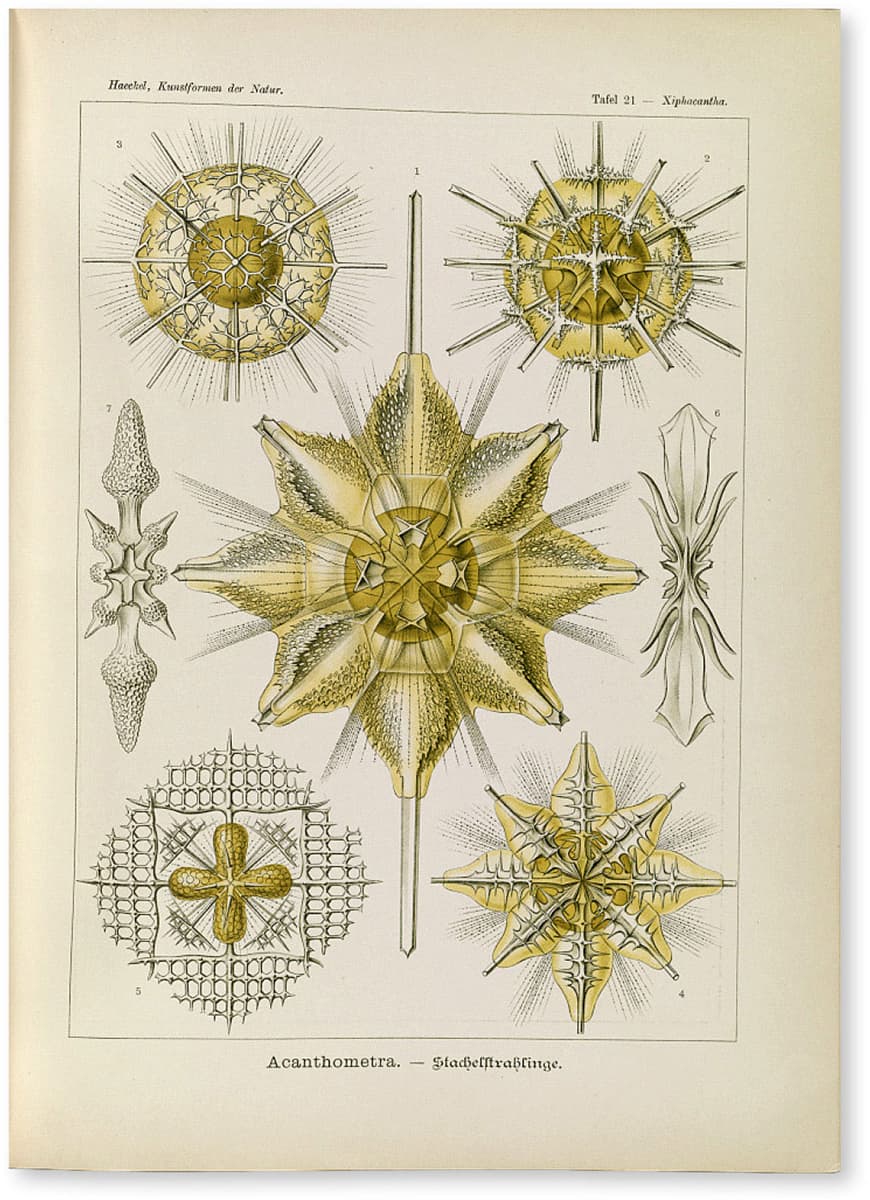
Ernst Haeckel
KUNSTFORMEN DER NATUR, BIBLIOGRAPHISCHEN INSTITUTS, 1899–1904
More images of Radiolaria (left), showing their jewel-like structures and of Blastoidea, extinct sea animals similar to sea urchins (right).

It’s interesting to contrast Haeckel’s highly visual approach with that of the French entomologist Jean-Henri Fabre, whose books on insects were also highly popular, not so much for the pictures as for his engaging writing style. Fabre, born in Saint-Léons in 1823, taught himself entomology and, without anthropomorphism, managed to give his descriptions of insects and their lives a kind of biographical style that made them highly approachable to a wider audience. He wrote a wide range of books, but his best-known was Souvenirs Entomologiques (Entomological Memories), first published in 1879 and continuing to be updated for two decades.
The last two decades of the nineteenth century, tipping into the twentieth century, also saw another example of illustrations from nature being used both scientifically and as works of art – but the big change here was that the illustrations were not reproductions of sketches and paintings, but photographs. The photographer in question was the remarkable Englishman, Eadweard Muybridge.
Born Edward Muggeridge in Kingston-upon-Thames in 1830, Muybridge spent most of his working life in America, first in San Francisco and later in Philadelphia. He started out as a landscape photographer, acquired notoriety when he murdered his wife’s lover (the jury found him not guilty as they considered this an appropriate response) and came to photographic and scientific fame when he devised a mechanism for taking a series of photographs in rapid succession – using a battery of cameras – which enabled him to analyse the motion of first horses and then other animals. In book form, Muybridge’s images were presented as a series of shots forming a now-iconic look in the history of photography, but he also put his series of photographs onto spinning discs, which were projected to provide very short sequences of moving pictures, amongst the first movies ever seen.
Eadweard Muybridge
ANIMAL LOCOMOTION, UNIVERSITY OF PENNSYLVANIA, 1887
Boxers and a bucking mule from Muybridge’s stop-motion images; when the boxers were shown animated at the Royal Institution, the Prince of Wales was reportedly ‘delighted’.
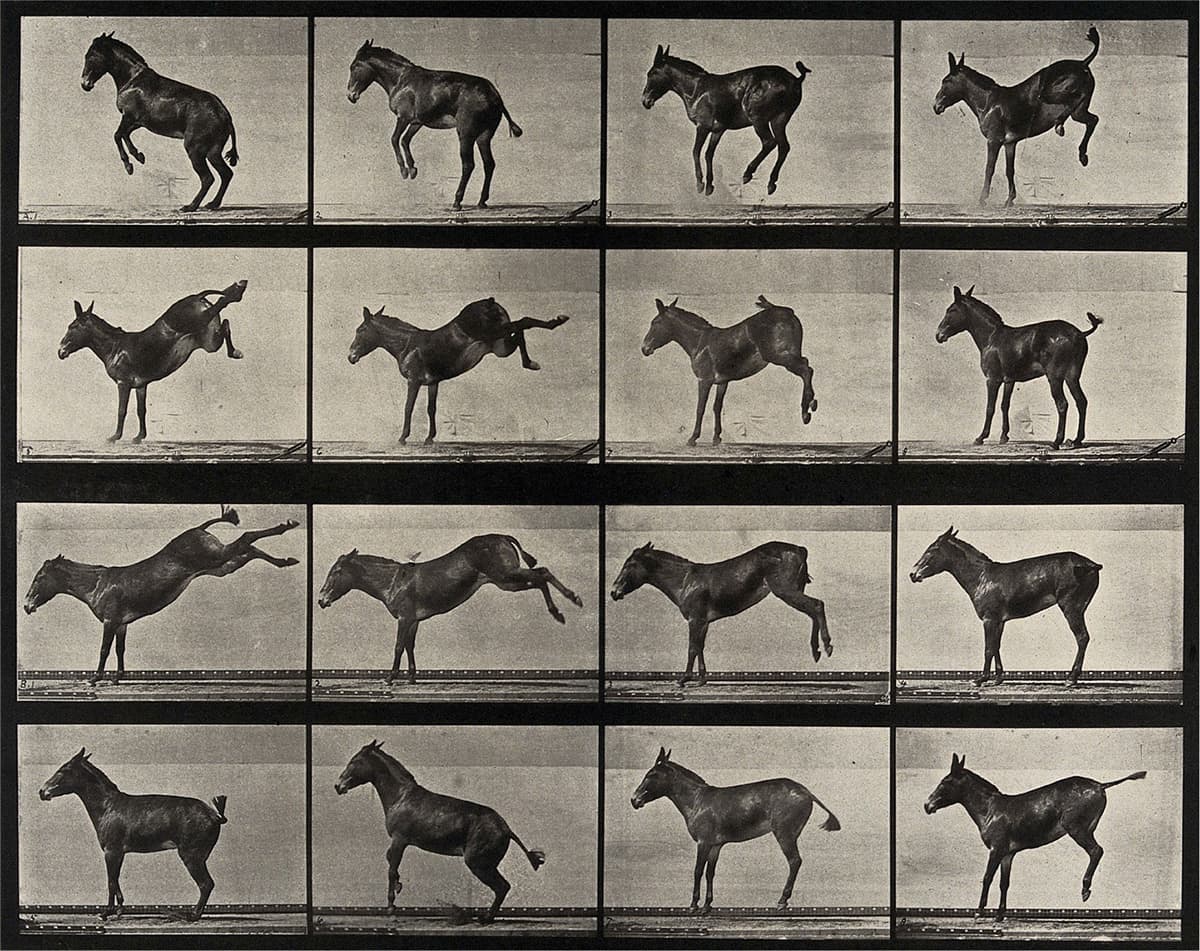
Eadweard Muybridge
ANIMAL LOCOMOTION, UNIVERSITY OF PENNSYLVANIA, 1887
Eagle in flight, from a range of sequences taken by Muybridge at Philadelphia Zoological Gardens using a 5-centimetre (2-inch) grid against a white cloth backdrop.
Muybridge produced a vast number of photographic series of everything from wild animals to the beating heart of a turtle and of humans carrying out various tasks (often naked to show their musculature). Rather like Haeckel, he started off by selling sets of prints, leading up to the production of what was, in some ways, his masterpiece, Animal Locomotion. This was not a book, but rather a collection of photograph prints with a catalogue and descriptive introductory text. It comprised 781 48 x 61-cm (19 x 24-inch) photographs, each of which could have as many as 24 images within it. The full collection sold mostly to institutions at a hefty $600, while there were also sets of 100 prints in a leather portfolio available for $100.
The reason Animal Locomotion was not published as a book was that in 1887, the technology to reproduce photographs in a book was in its infancy. However, Muybridge’s work had already found its way into book form, in a manner that put his whole career at risk. In 1882, while in London on a successful tour with his moving pictures, he had been due to give a talk at the Royal Society when he was summoned to account for himself and shown a book called The Horse in Motion by a J. D. B. Stillman. This contained engravings based on his photographs – but Muybridge himself was not mentioned. The book had been put out on behalf of Muybridge’s former sponsor, railroad magnate and founder of Stanford University, Leland Stanford. The way that the book did not consider Muybridge worthy of mention seemed to indicate to the Royal Society’s committee that Muybridge had been nothing more than a technician, rather than the inventor of this technology. Muybridge sued Stanford with little success, but luckily the Stillman book did not sell well, and when Muybridge went on to produce vastly superior images from his work at the University of Pennsylvania, his expertise was recognised.
By the end of the century, technology had advanced, and Muybridge was able to publish two books that brought his works to a much wider public. These were Animals in Motion and The Human Figure in Motion, published in the UK in 1899 and 1901 respectively. The photographic quality might not have been as great as that in Animal Locomotion, but the book form brought the images and text covering the technology and the scientific value of the images to a much wider audience. As the Human Figure book contained a considerable amount of nudity, one review, in The Graphic in December 1901, thought it wise to warn, ‘It will be understood that the volume, not being intended virginibus puerisque [literally: for virgins and for boys] (unless they be full-fledged students) should not be left on the drawing room table.’
Uncovering the foundations of mathematics and continents
We have seen through the nineteenth century a gradual move from science books written purely as a means of communication between natural philosophers to those serving as more of a bridge between the science community and the general public. Although the public may not have appreciated the biological message in Kunstformen or the technical wizardry of Muybridge’s photography, there was no doubt that they could enjoy the artistry. This did not mean, though, that books that could only be of interest to a particular field had entirely disappeared.
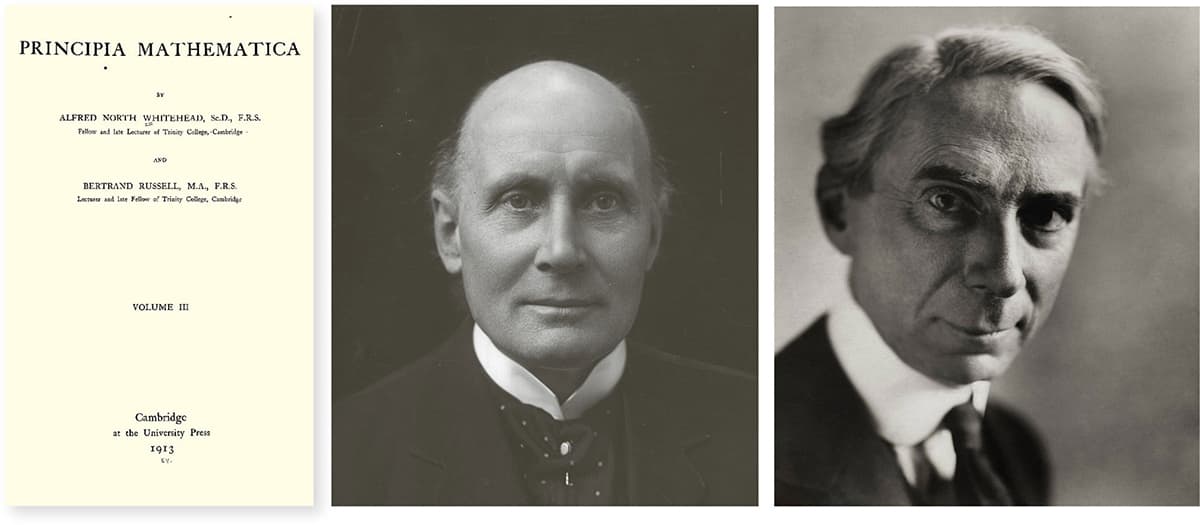
Alfred North Whitehead and Bertrand Russell
PRINCIPA MATHEMATICA, CAMBRIDGE UNIVERSITY PRESS, 1913
The title page of the third volume of Whitehead and Russell’s mathematical tour de force, alongisde portraits of Whitehead ca. 1925 (left) and Russell in 1927 from Vanity Fair magazine (right).
There were, of course, still textbooks, from those for school-age students up to postgraduate works. However, the textbook has always been a very specialist form. And though the majority of scientists exchanged information with their peers through the form of a scientific paper published in a journal, sometimes they would set off on an endeavour of sufficient depth that it required a book to get their ideas across.
Such works included Grundlagen der Geometrie (Foundations of Geometry) from 1899 by the German mathematician David Hilbert, which set modern starting points for Euclidean geometry, and, more notably, the three-volume Principia Mathematica (Principles of Mathematics) by mathematician Alfred North Whitehead and philosopher Bertrand Russell, published between 1910 and 1913. The latter book, despite its Latin title (no doubt a nod to Newton), was written in English – or more realistically in mathematics, as the purpose was to build the structure of mathematics from its most basic form, starting from a set of simple assumptions (axioms) in symbolic logic and constructing as much of the hierarchy of mathematics from there as was possible.
Perhaps the best-known aspect of this weighty book was the appearance, on page 379 of the original edition, of the words ‘From this proposition it will follow, when arithmetical addition has been defined, that 1 + 1 = 2.’ It took 379 pages to get that far. Given this, by the end of the third volume the authors, not surprisingly, had to admit defeat, realising they could only cover a tiny fraction of the mathematics of the time. Ironically, by 1931 the Austrian mathematician Kurt Gödel had proved that any system of mathematics must either be inconsistent or incomplete – such a book could never in fact be written for the whole of mathematics. Nonetheless, Principia Mathematica was a landmark book in the philosophy of mathematics.
Alfred Wegener
DIE ENTSTEHUNG DER KONTINENTE UND OZEANE, FRIEDRICH VIEWEG & SOHN, 1920
The cover of the second edition of Wegener’s (literally) groundbreaking title setting out the concept of continental drift; his ‘tectonic plate’ theory was not accepted in his lifetime. The first edition was published in 1915.
Published two years after the final volume of Principia Mathematica, a title by German geophysicist and meteorologist Alfred Wegener is particularly interesting for being so far ahead of its time. Wegener, born in Berlin in 1880, set out a theory in his Die Entstehung der Kontinente und Ozeane (The Origin of Continents and Oceans) that would not be widely accepted until at least 20 years after his death in 1930. In a way, it’s not surprising. The central idea of Die Entstehung der Kontinente und Ozeane, first published in 1915, was a remarkable one: that the apparently solid surface of the Earth in fact consisted of great plates of rock that were moving with respect to each other.
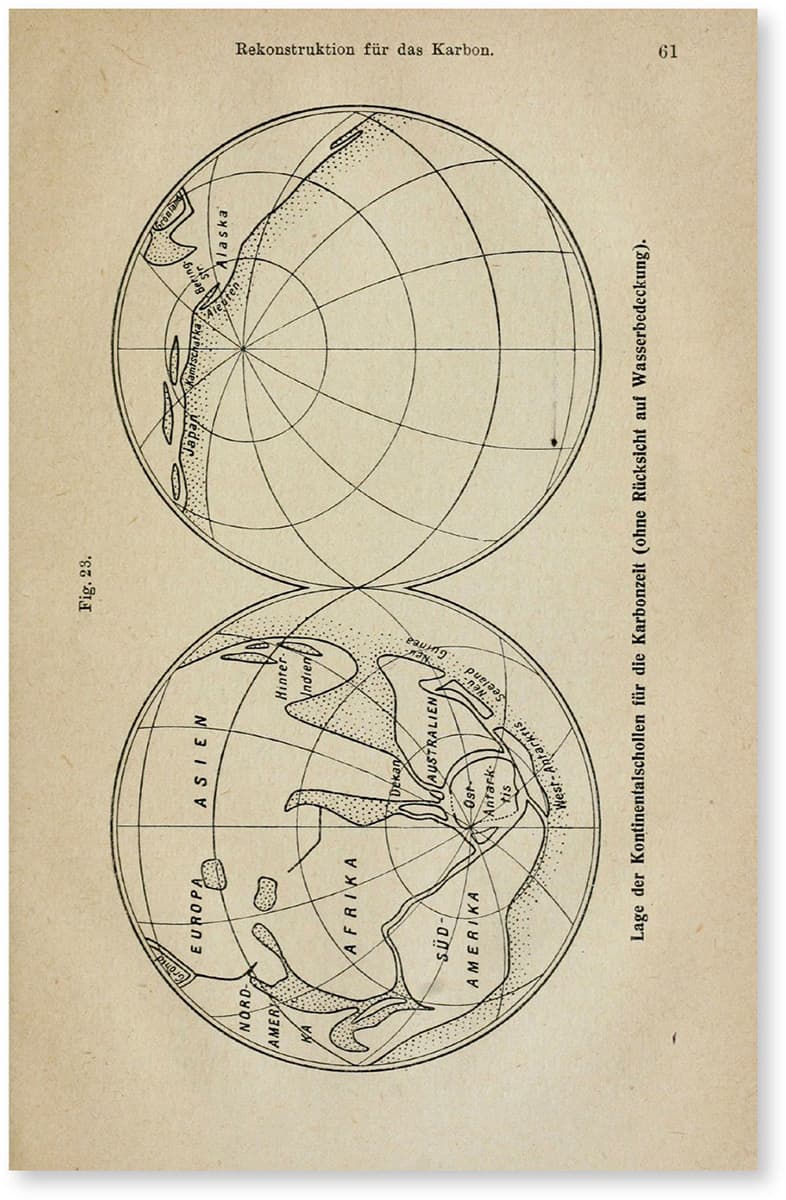
Alfred Wegener
DIE ENTSTEHUNG DER KONTINENTE UND OZEANE, FRIEDRICH VIEWEG & SOHN, 1920
Images, as they were orientated, from the second edition of Wegner’s book. They show his concept of how the continents had originally been positioned against each other and drifted apart.
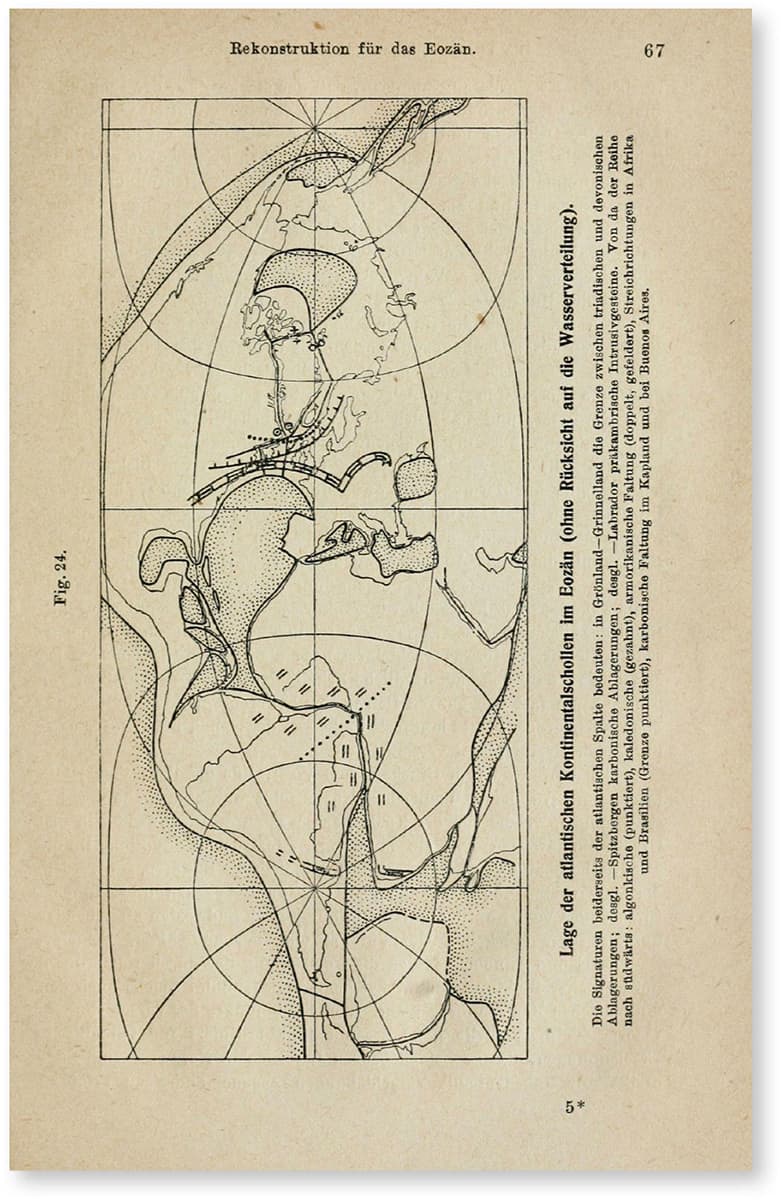
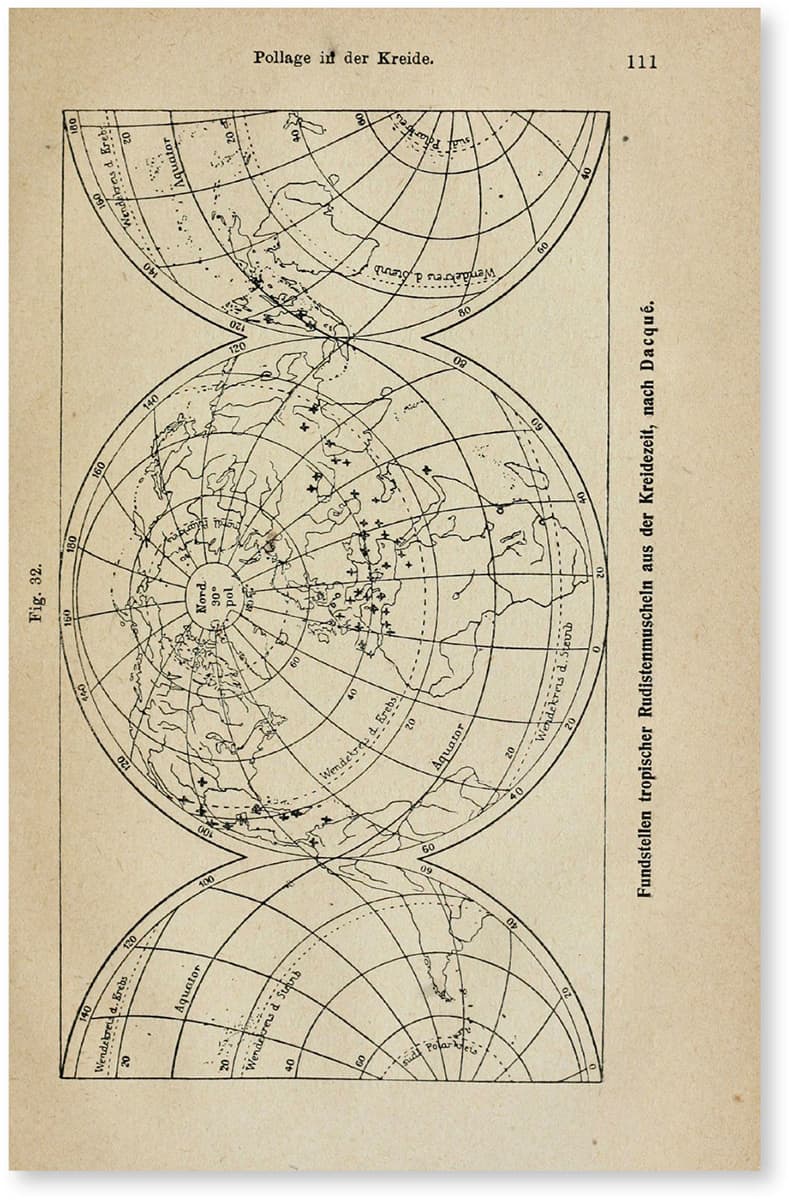
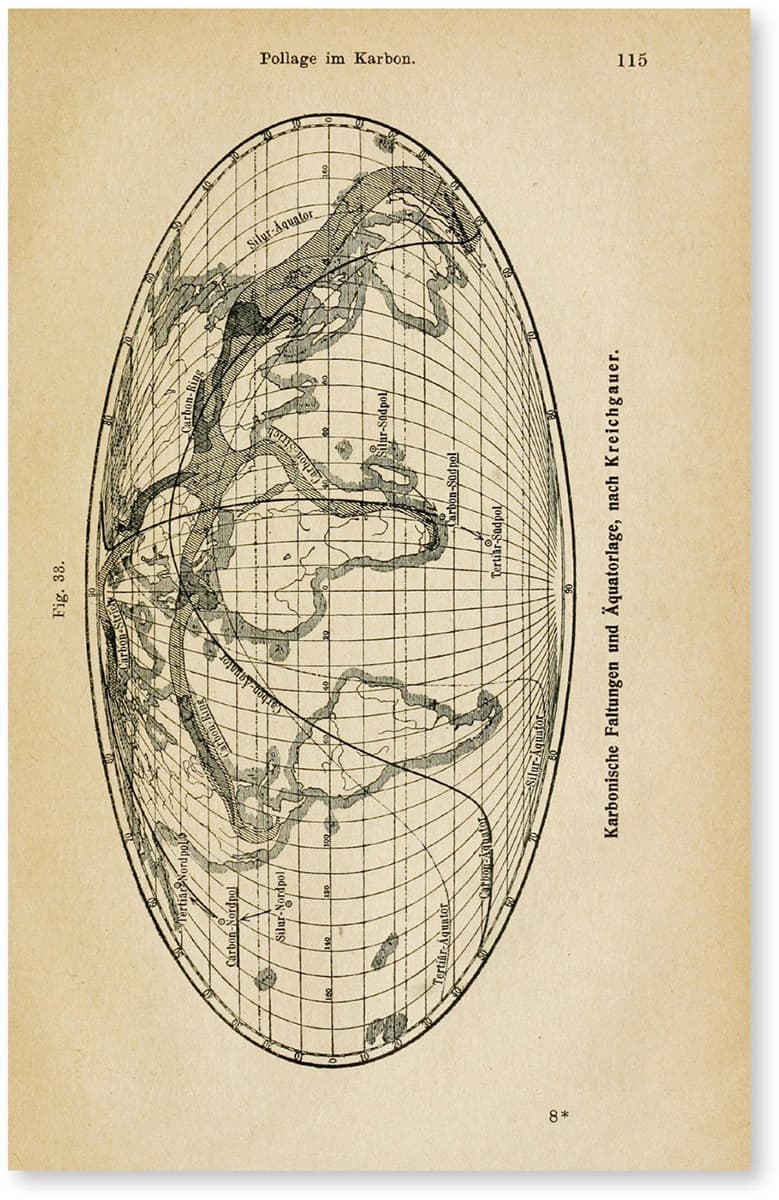
The starting point of Wegener’s great idea was the way that different landmasses, such as the Americas set alongside Africa and Europe, seemed to fit together like a jigsaw puzzle that had been split apart. He also noted similarities in the fossil record between continents now separated by ocean, as if these landmasses had once been contiguous. Wegener proposed that the continents very gradually moved relative to each other, so that over geological time, new continental structures could form and break up.
There were many reasons why Wegener’s theory was not accepted during his lifetime. Wegener was better known at the time for his work in meteorology and Greenland expeditions than geology – he died as supplies ran out under intense Arctic weather on the last of his expeditions. And it didn’t help that he could not come up with a convincing mechanism for the movements of the Earth’s surface on such a vast scale. He also overestimated the rate of continental drift by a factor of 100, which not surprisingly resulted in a considerable degree of scepticism. Even so, his book would come to be regarded as a posthumous masterpiece when it was realised how well his theory matched a growing understanding of the way the Earth operated.
The absence of women
Before concluding this chapter, we need to revisit the place of women in science and science writing. A slow revolution was under way during the nineteenth century, but it’s notable that there were still very few books by women on science written during this period. We don’t have to look further than the words of one of the heroes of the nineteenth century, Charles Darwin, to see why. In his books, notably The Descent of Man, Darwin’s opinions aligned with the widely accepted view of the period that women were intellectually inferior (despite Darwin himself getting considerable assistance in his work from female members of the family). He wrote, ‘If two lists were made of the most eminent men and women in poetry, painting, sculpture, music … history, science and philosophy … the two lists would not bear comparison.’
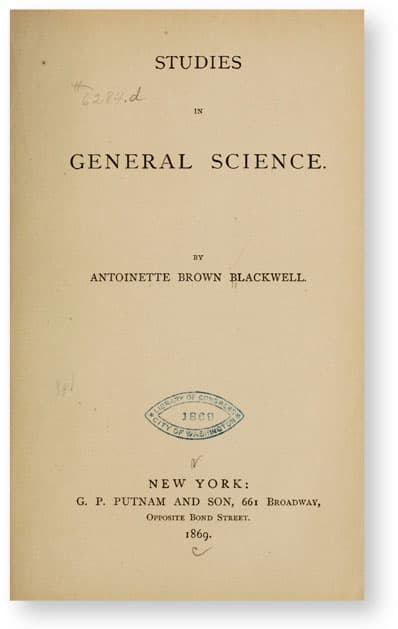
Antoinette Brown Blackwell
STUDIES IN GENERAL SCIENCE, G. P. PUTNAM AND SON, 1869
The title page of Brown Blackwell’s book, which received a positive response from Darwin who (somehow) assumed the author was male.
This view was countered by American author Antoinette Brown Blackwell. She had sent a copy of her first book, Studies in General Science, to Darwin and received a very positive response, but noticed that Darwin had assumed she was male. She would respond by writing a book called The Sexes Throughout Nature in 1875, which directly challenged the idea of female inferiority. Darwin’s opinion of this is not recorded.
There has been some effort to rescue Darwin’s reputation by noting the considerable correspondence he had with women who he seemed to treat as intellectual equals, but this rather sidesteps his damning correspondence with another American woman, Caroline Kennard. She wrote to Darwin in 1881, shocked to discover that Darwin was being cited as a source of scientific principles demonstrating the inferiority of women. Mrs Kennard asked him, ‘If a mistake has been made, the great weight of your opinion and authority should be righted.’ She was clearly expecting Darwin to support the concept of equality. Unfortunately, he replied, ‘I certainly think that women though generally superior to men [in] moral qualities are inferior intellectually, and there seems to me to be a great difficulty from the laws of inheritance, (if I understand those laws rightly) in their becoming intellectual equals of man.’ Darwin’s response seemed to have been based on the idea that men had been forced to evolve more due to their traditional roles, while women had been unable to keep up, despite inheriting some positive traits from the male line.
Darwin also argued that for women to be equal they would have to become breadwinners, potentially damaging their children and the happiness of their households. Mrs Kennard wrote back an angry response, pointing out that in the majority of (lower-class) households women did work, but were prevented from doing anything other than menial jobs, and any perceived inferiority was due to their environment and restraints on what they were allowed to do, not their ability.
Nonetheless, despite the attitudes of Darwin and others, towards the end of the nineteenth century, science was gradually changing, and barriers were being broken down. Women were being admitted to study sciences at an increasing number of universities around the world and would begin to contribute to science writing. It was a slow process, and many of the great scientists of the time proved conservative. For example, when James Clerk Maxwell opened the Cavendish Laboratory for experimental physics at Cambridge in 1874, he was reluctant to allow women into the building. Ironically, Maxwell’s wife Katherine had been actively involved in some of her husband’s experimental work, but it seems that having women as undergraduates was one step too far for Maxwell. Later in the 1870s he relented and allowed women into the laboratories, though his assistant William Garnett noted, ‘At last [Maxwell] gave permission to admit women during the Long Vacation, when he was in Scotland, and I had a class who were determined to go through a complete course of electrical measurements during the few weeks when the laboratory was open to them.’
By the start of the twentieth century, the first female professional scientists became established. Famously, Marie Curie (see here) became the first woman to win a Nobel Prize in a science subject in 1903 with the Physics prize, and she went on to take the Chemistry prize in 1911. (Less impressively, it’s worth noting that by 2018 there have been only two other female winners of the Nobel Prize in Physics: Maria Goeppert-Mayer in 1963, and Donna Strickland in 2018.) Progress was slow, however, and if anything, science publishing would prove even slower to give opportunities to women writers, with only a handful of notable publications appearing before the 1970s.
Despite this glacial advance in gender equality, the twentieth century would bring both a revolution in science and in the way that science books were written.
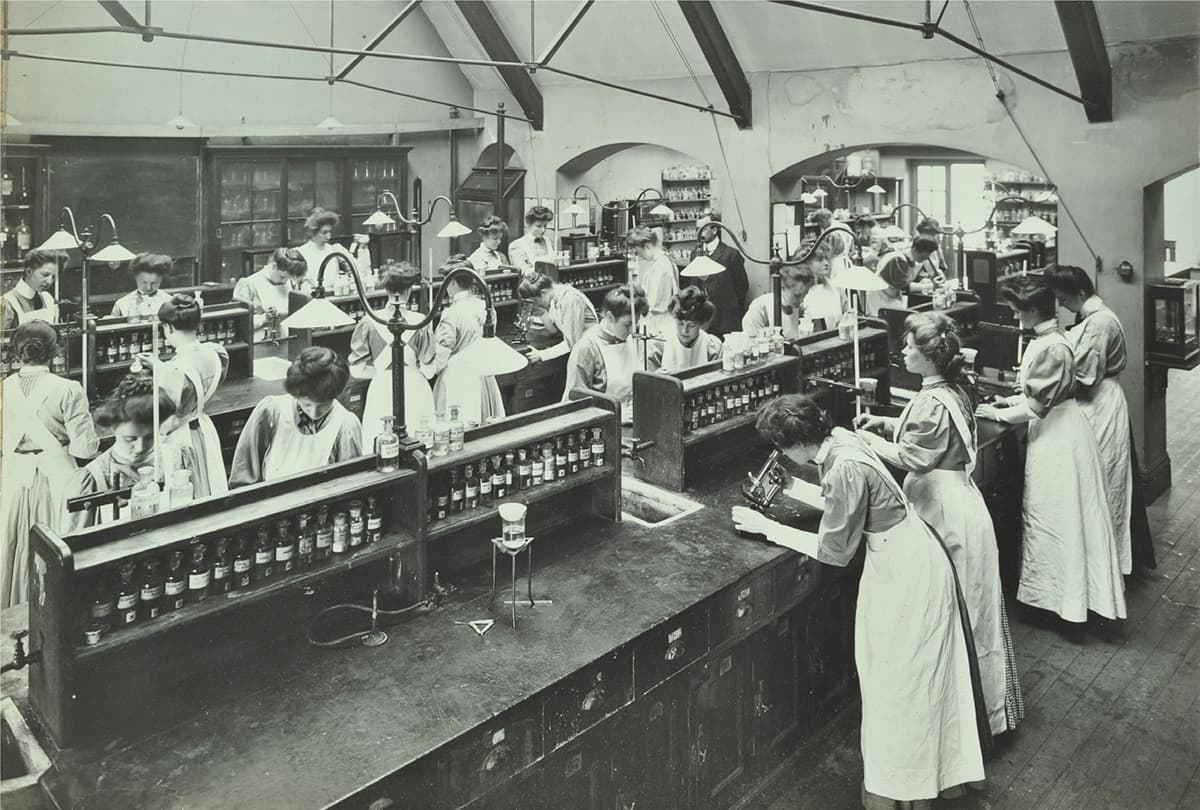
DOMESTIC CHEMISTRY CLASS, 1907
Female students at work in a laboratory at Battersea Polytechnic, London.

